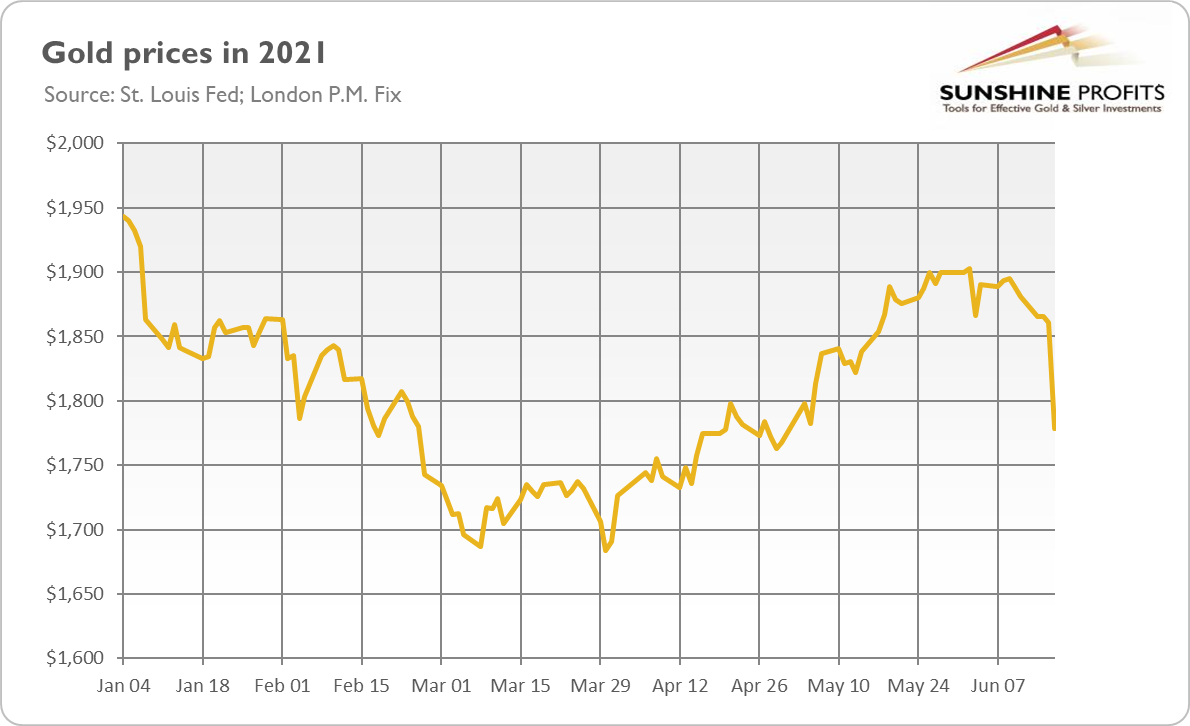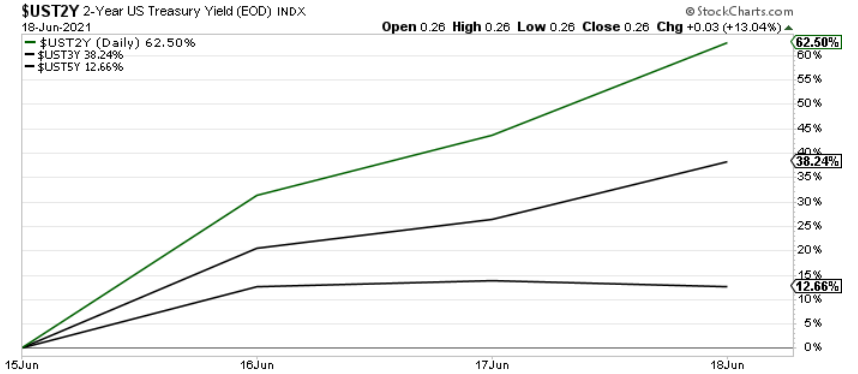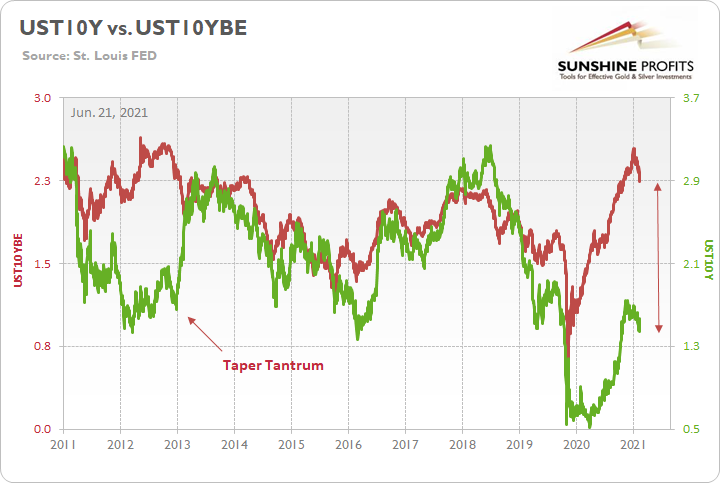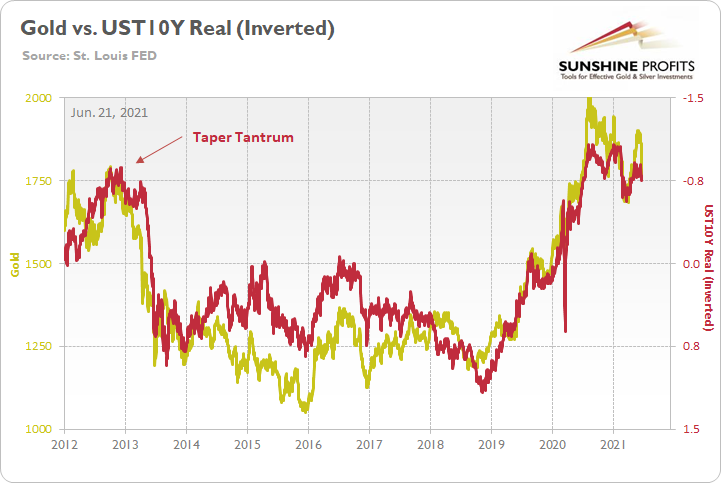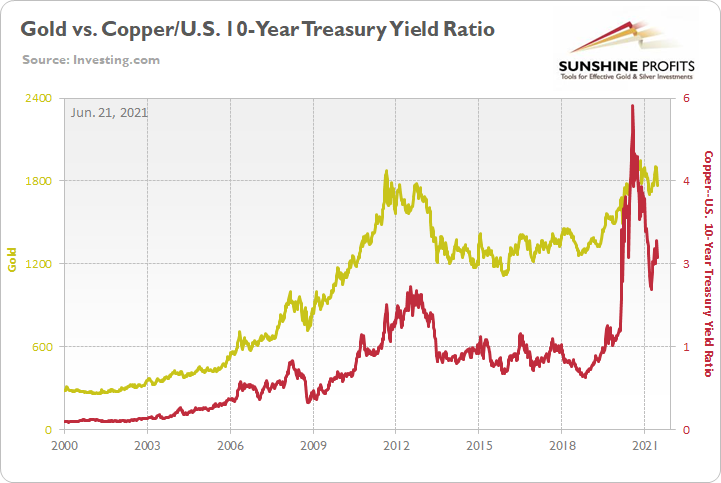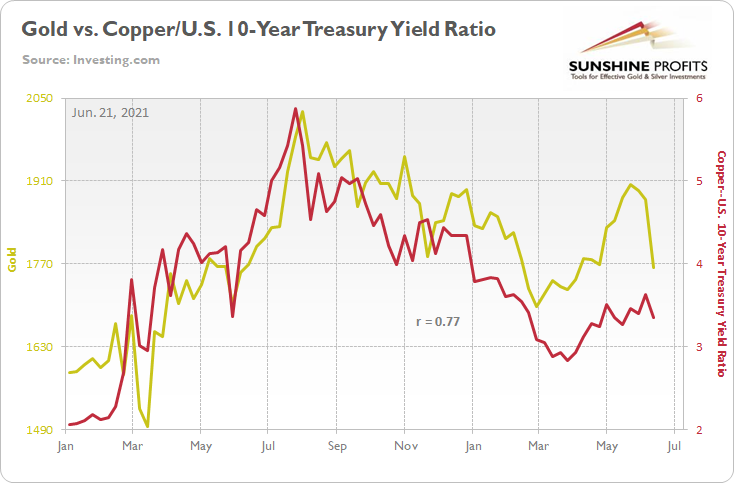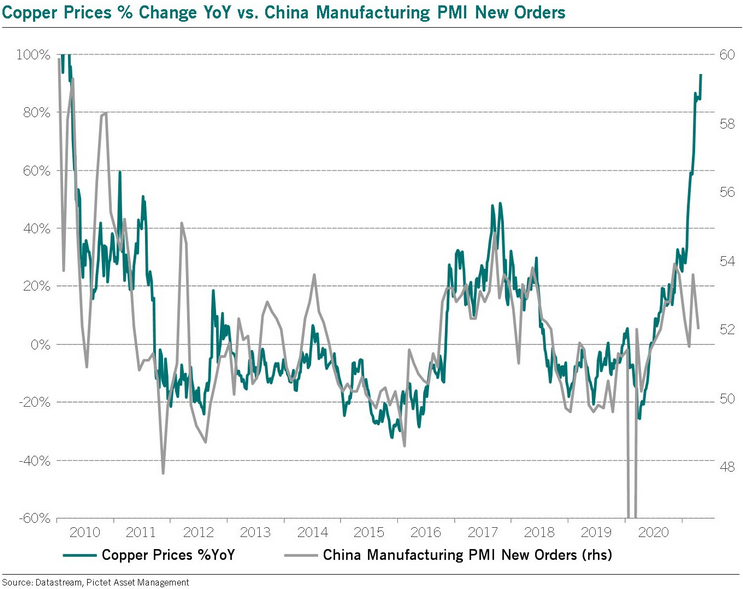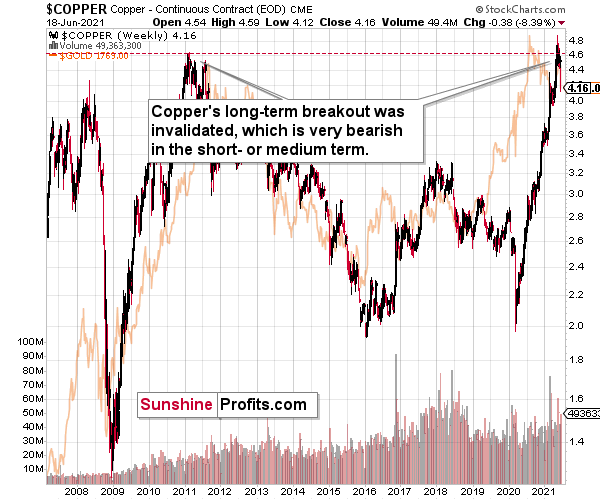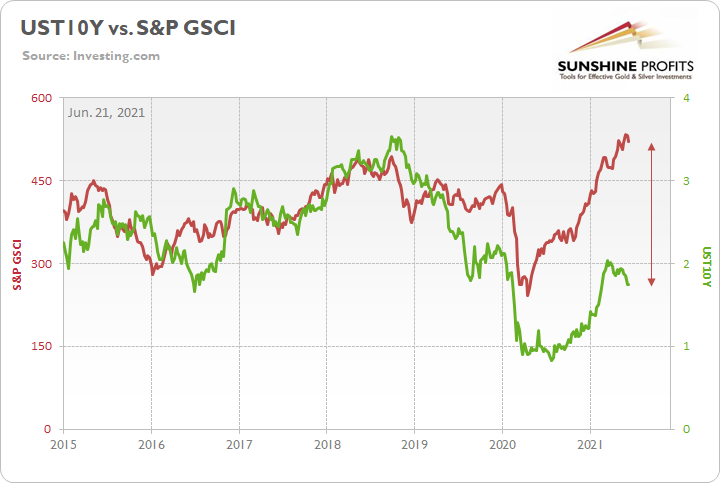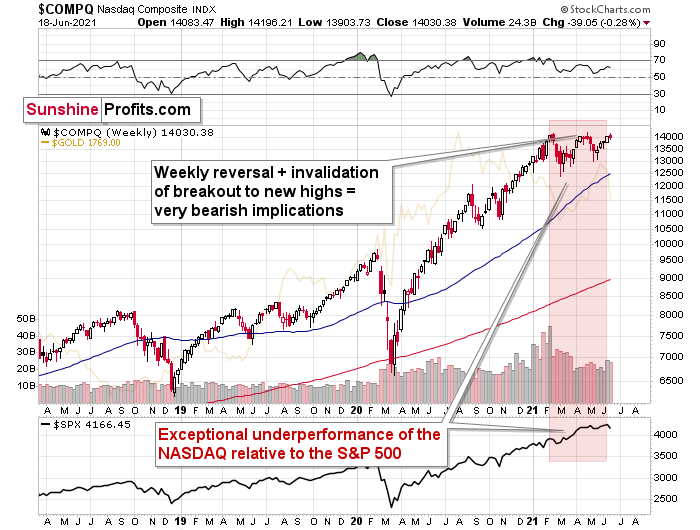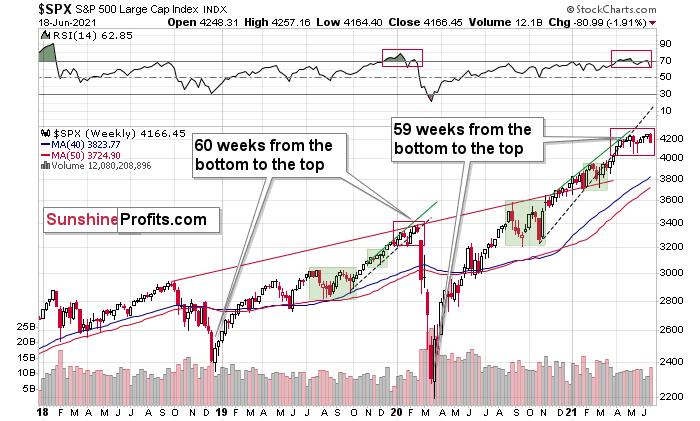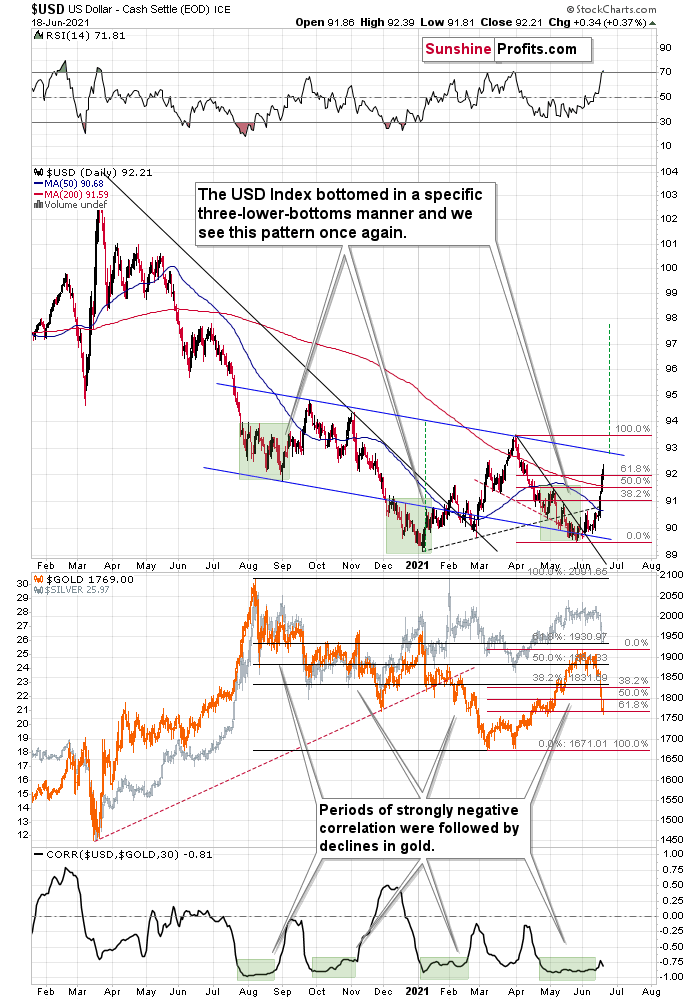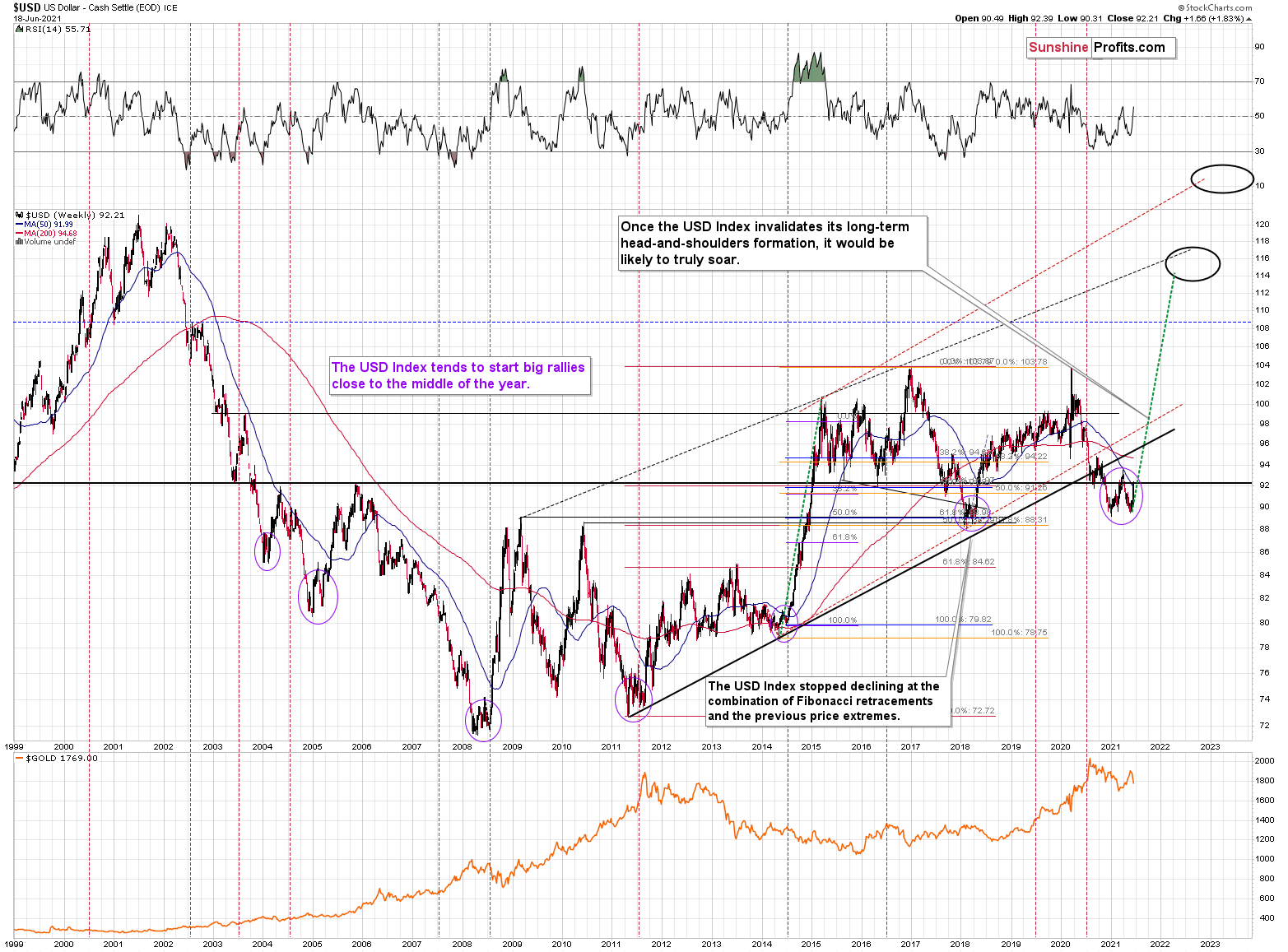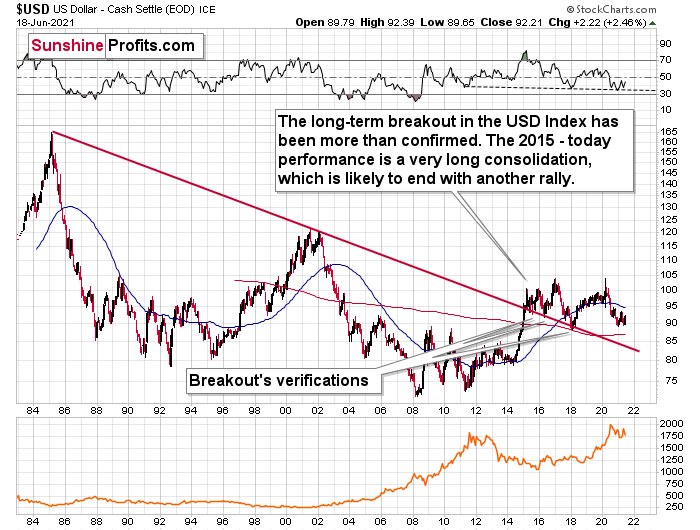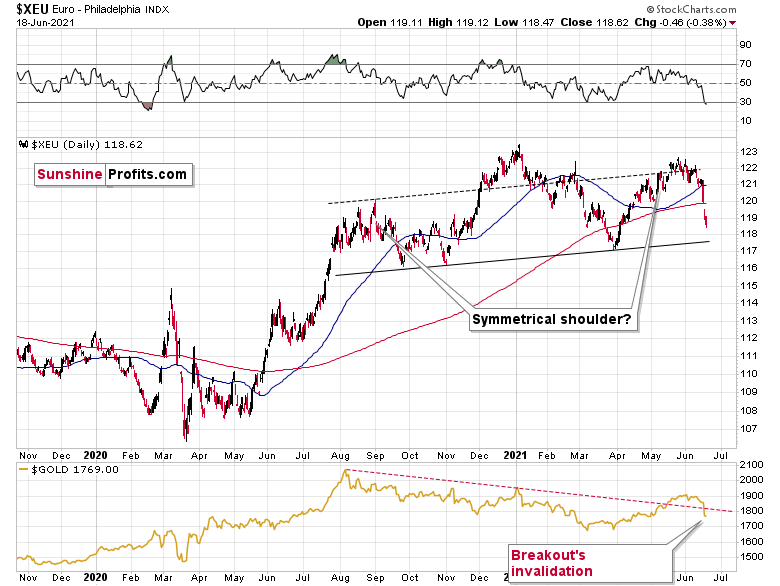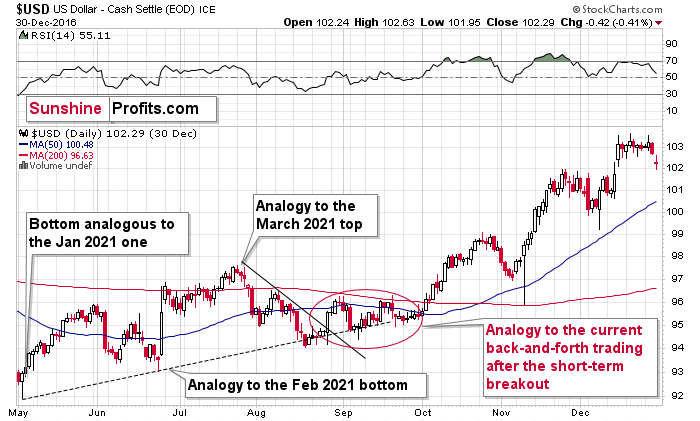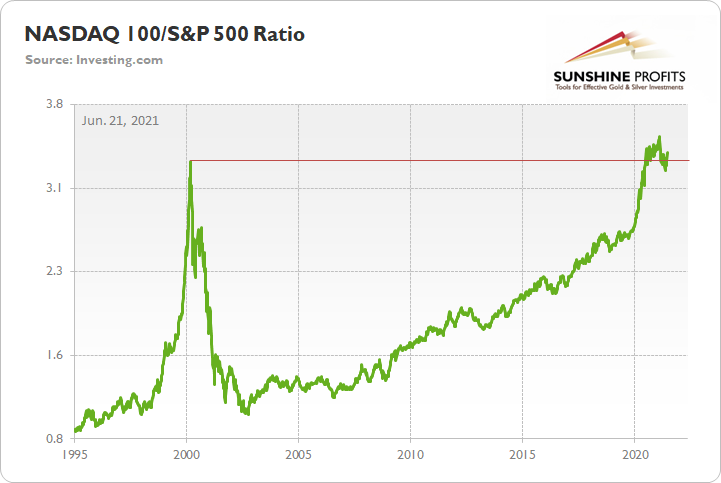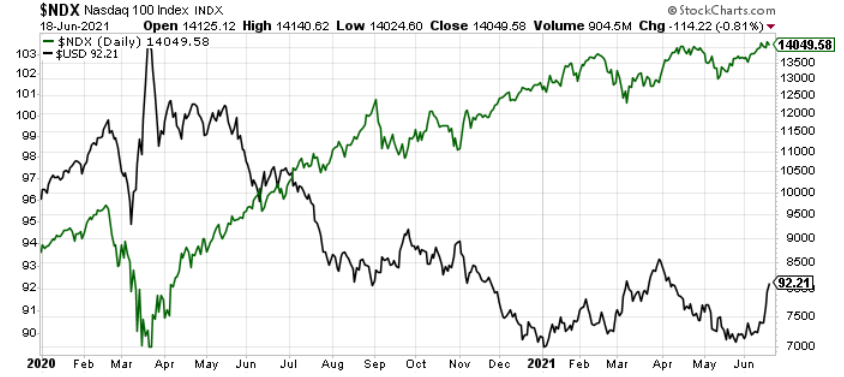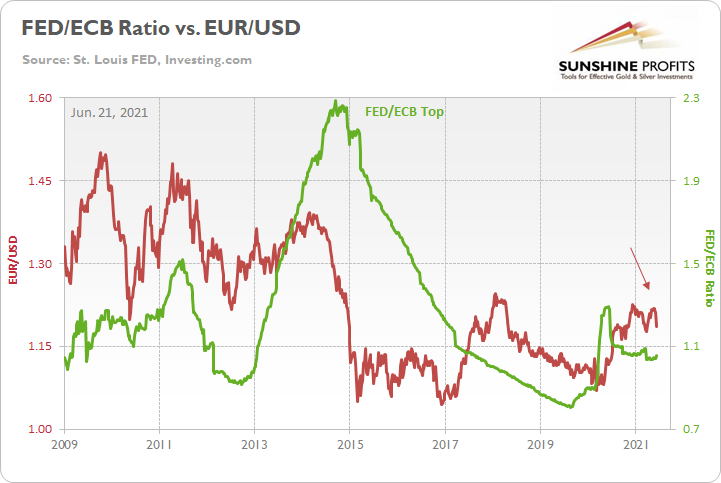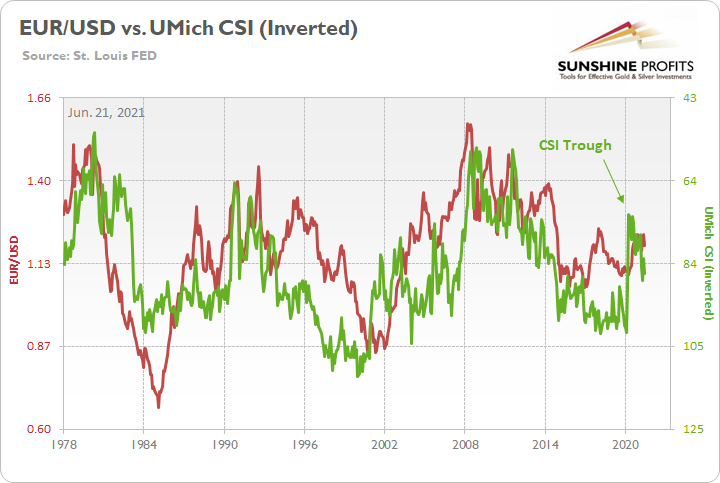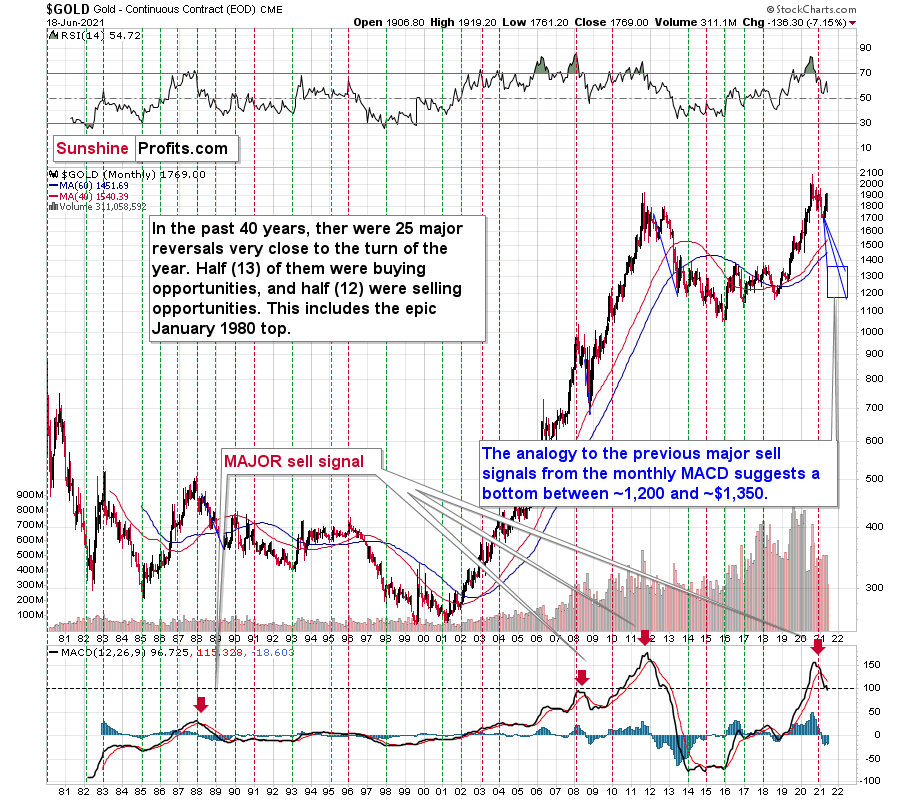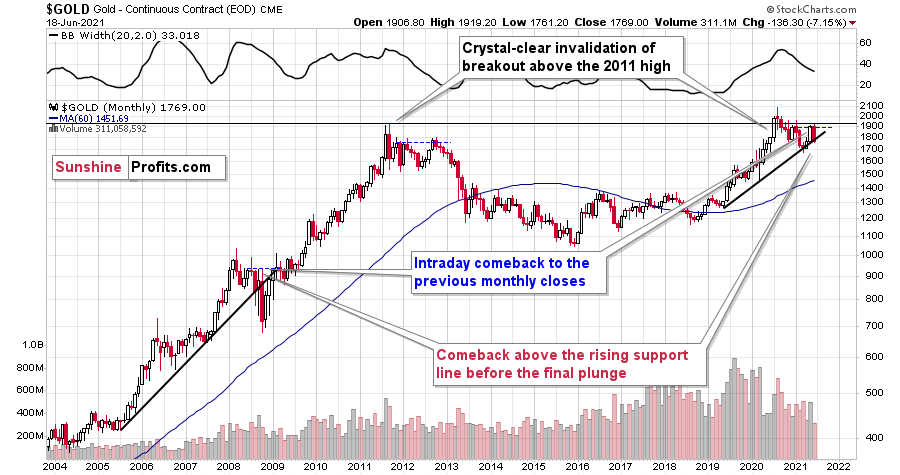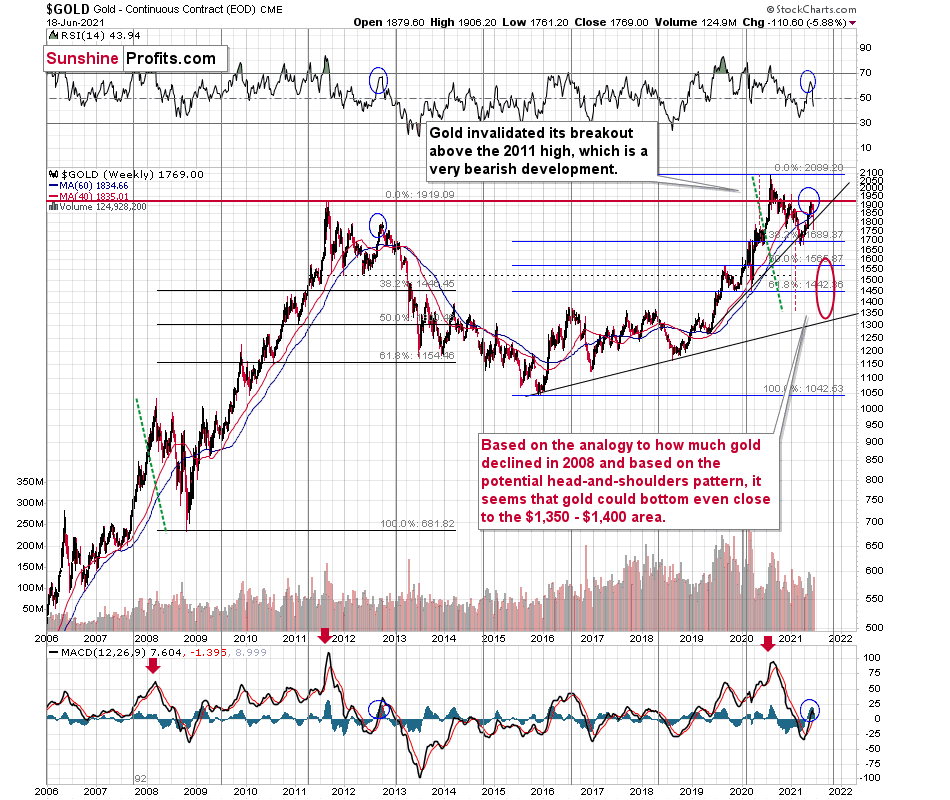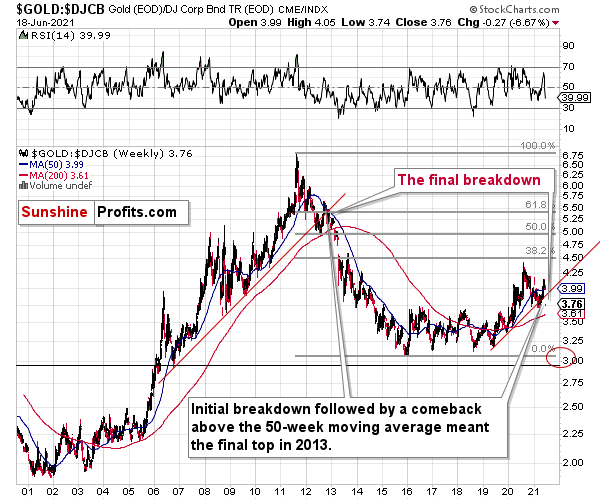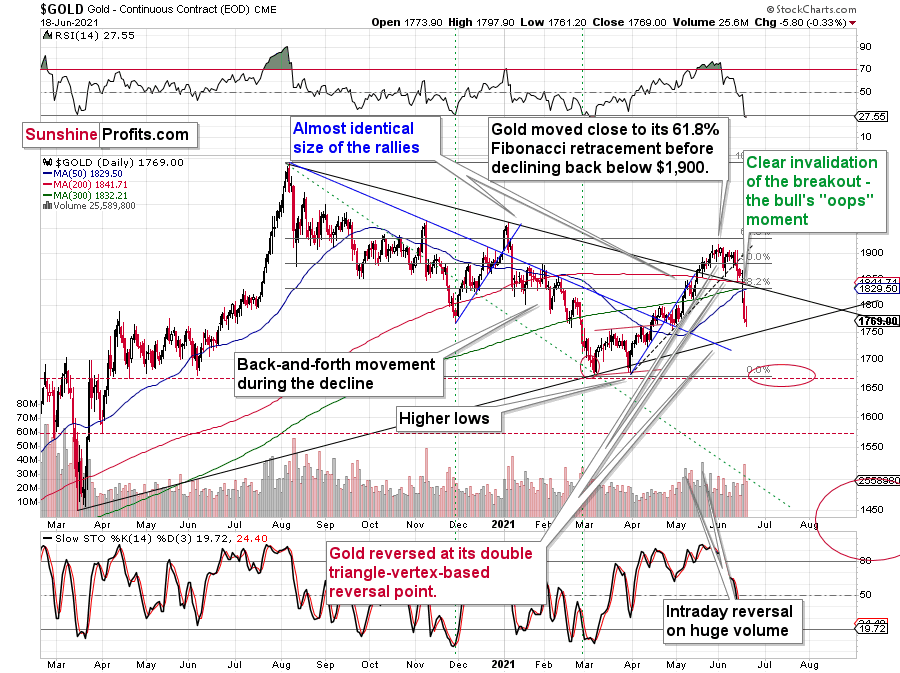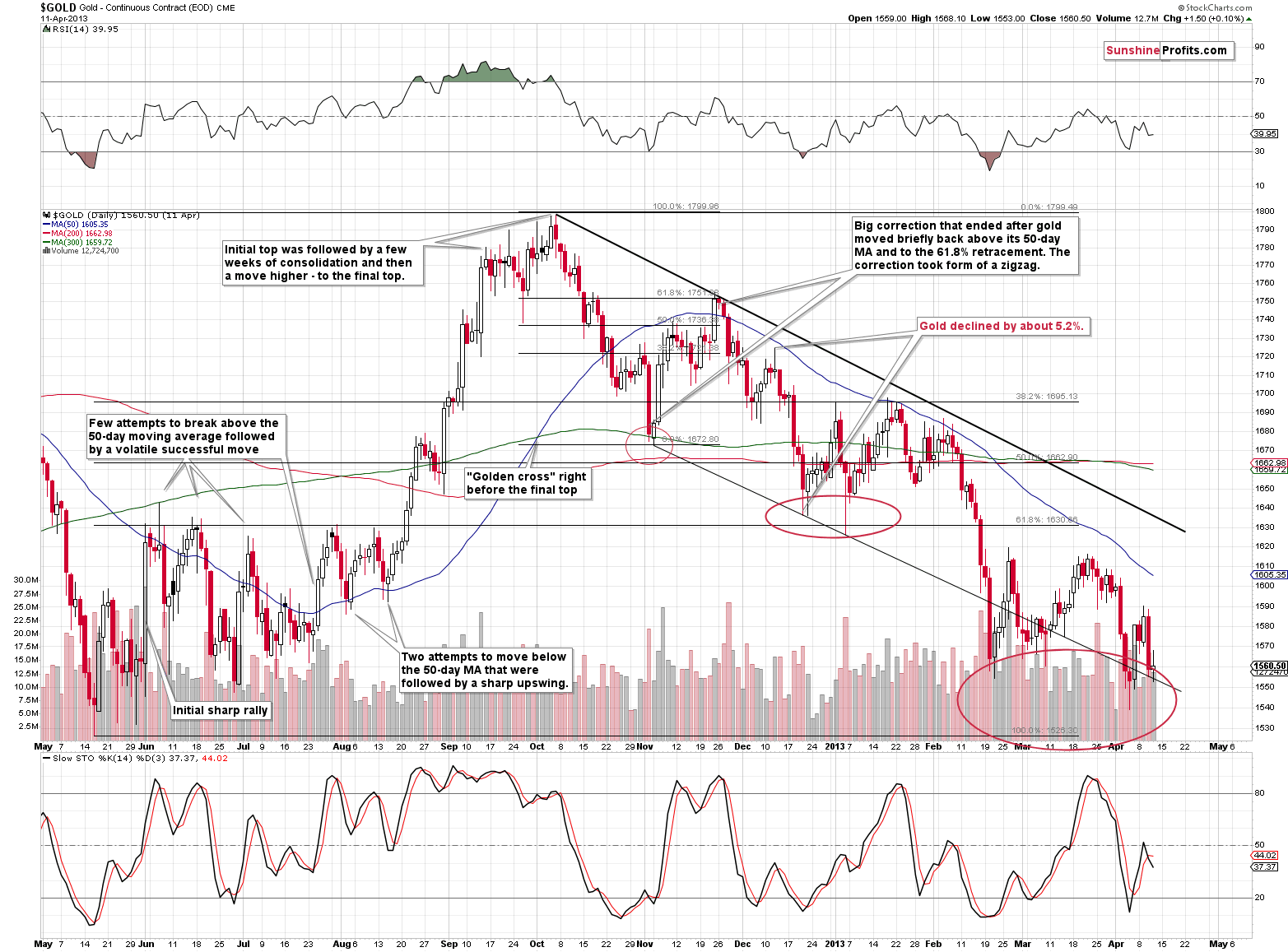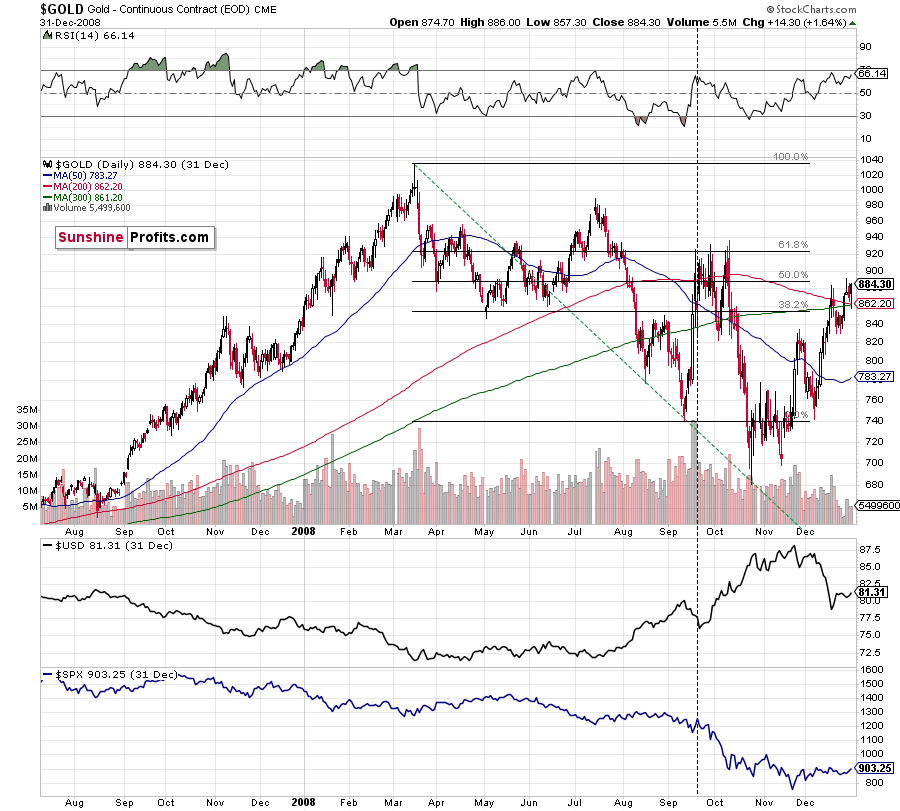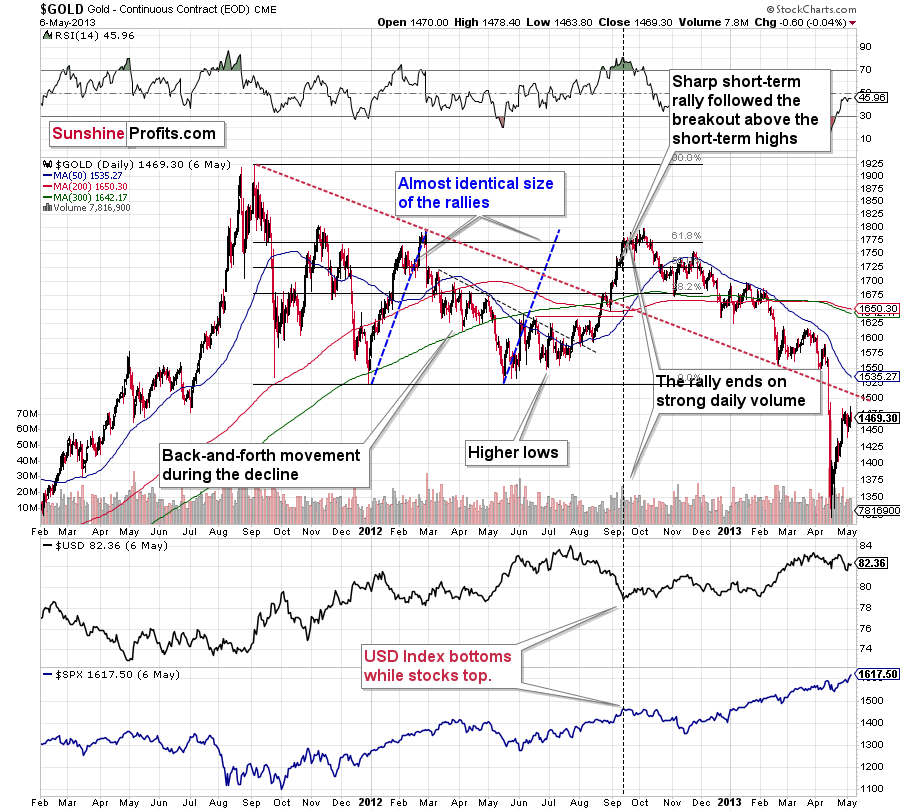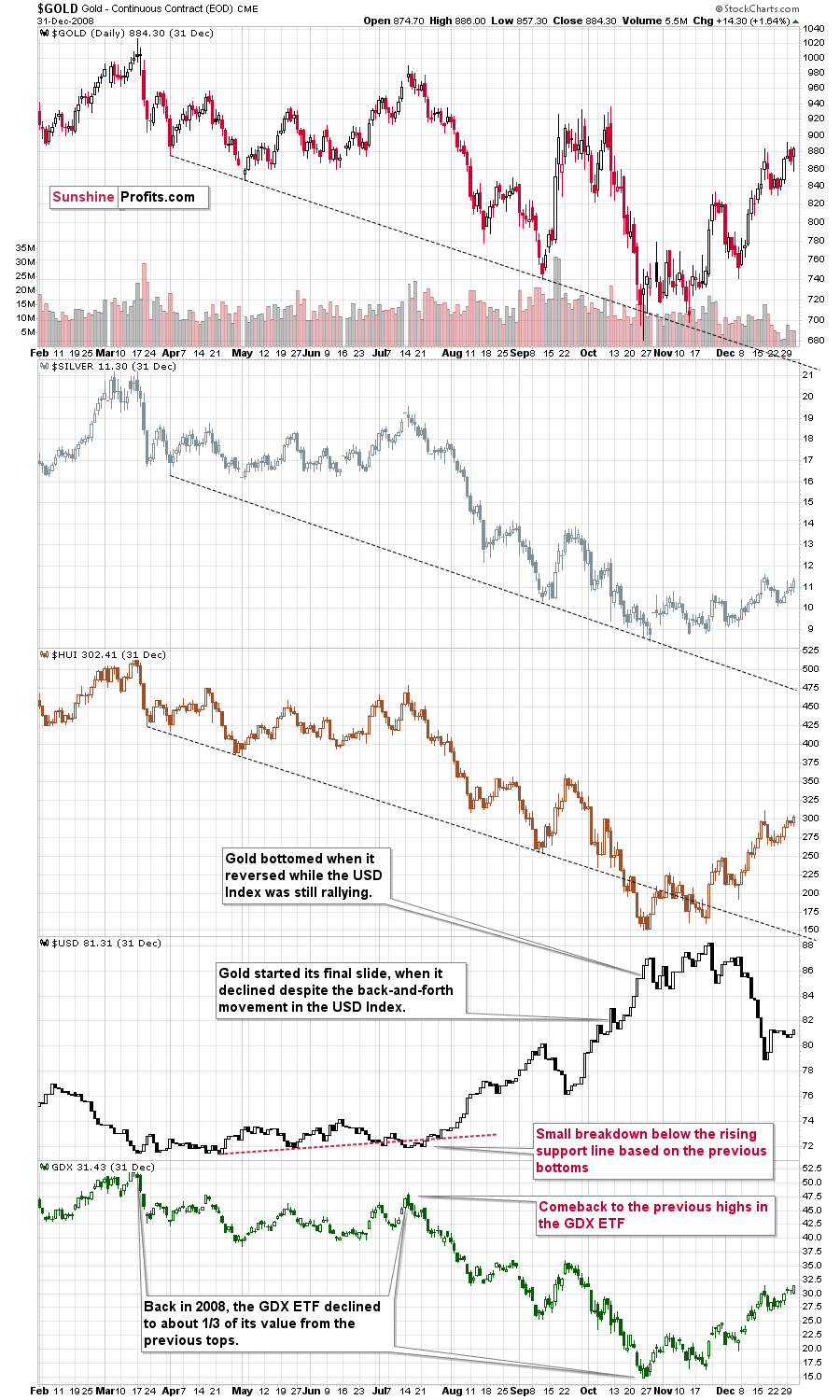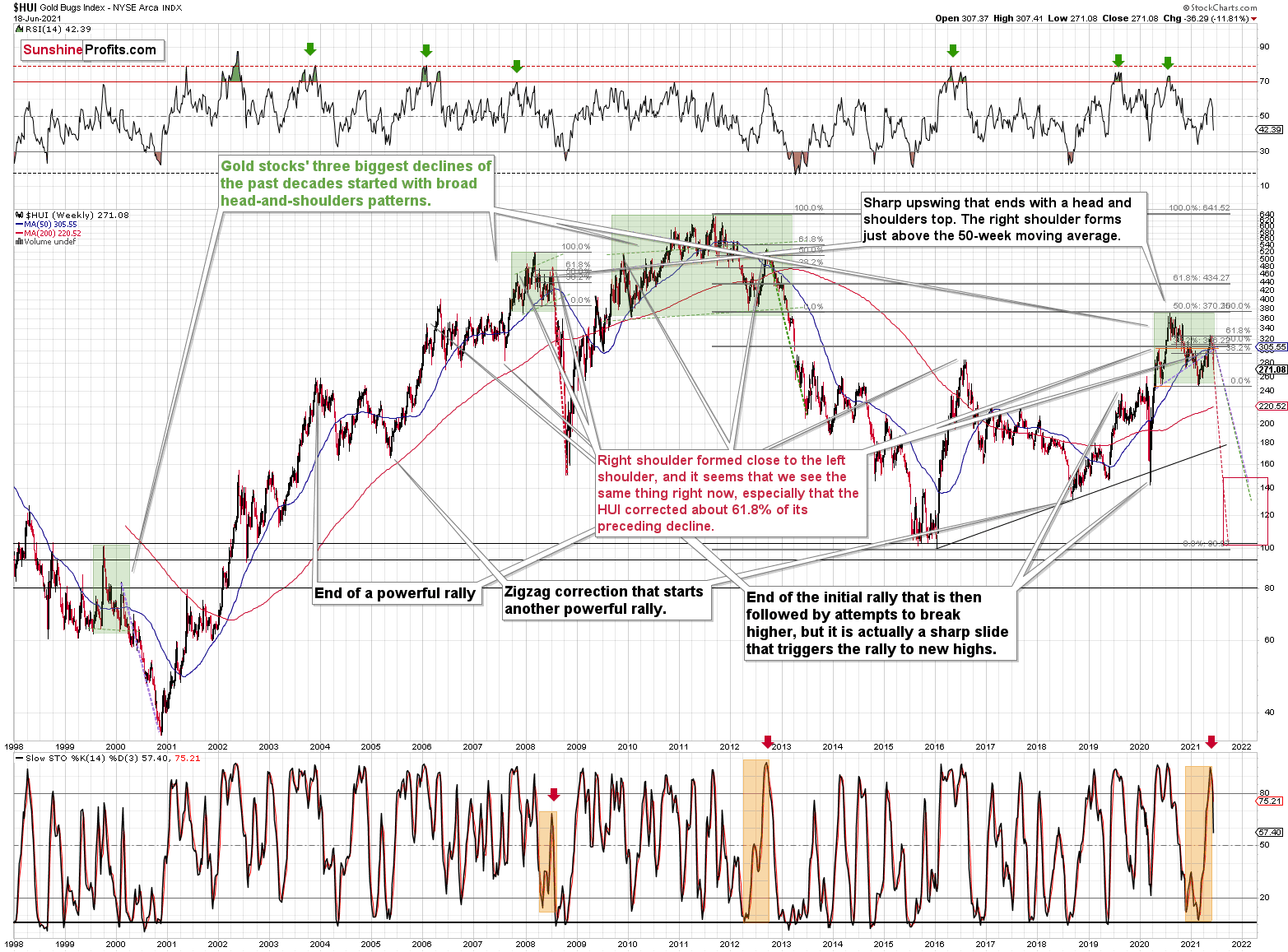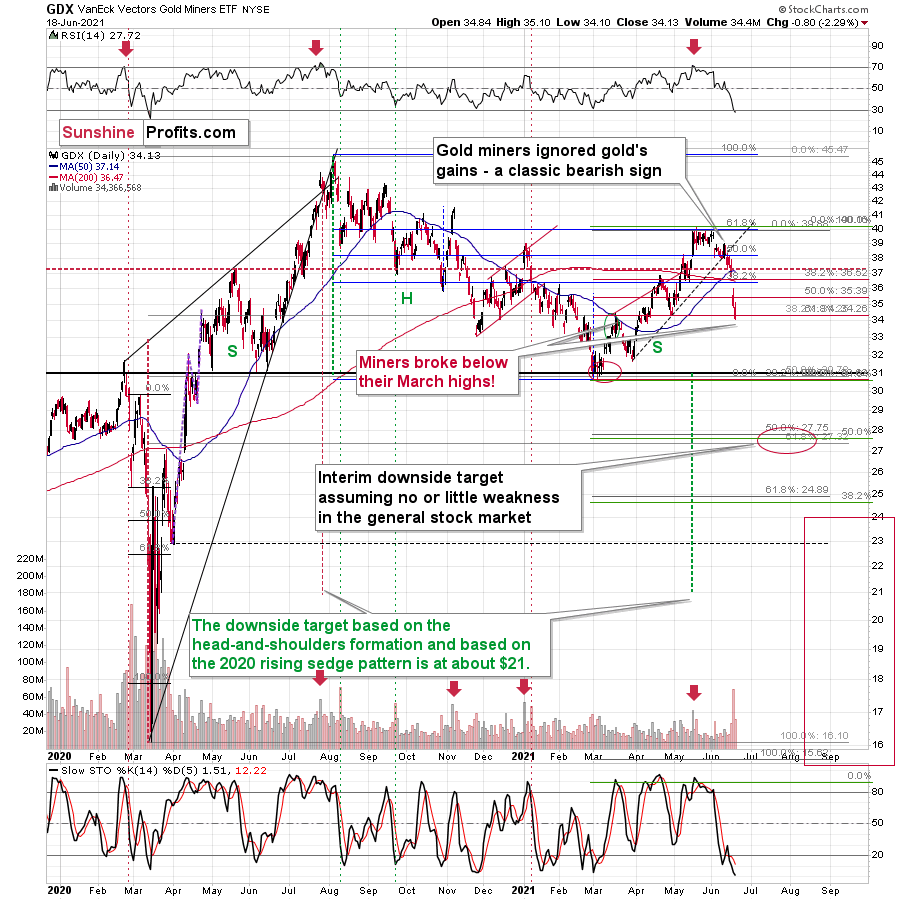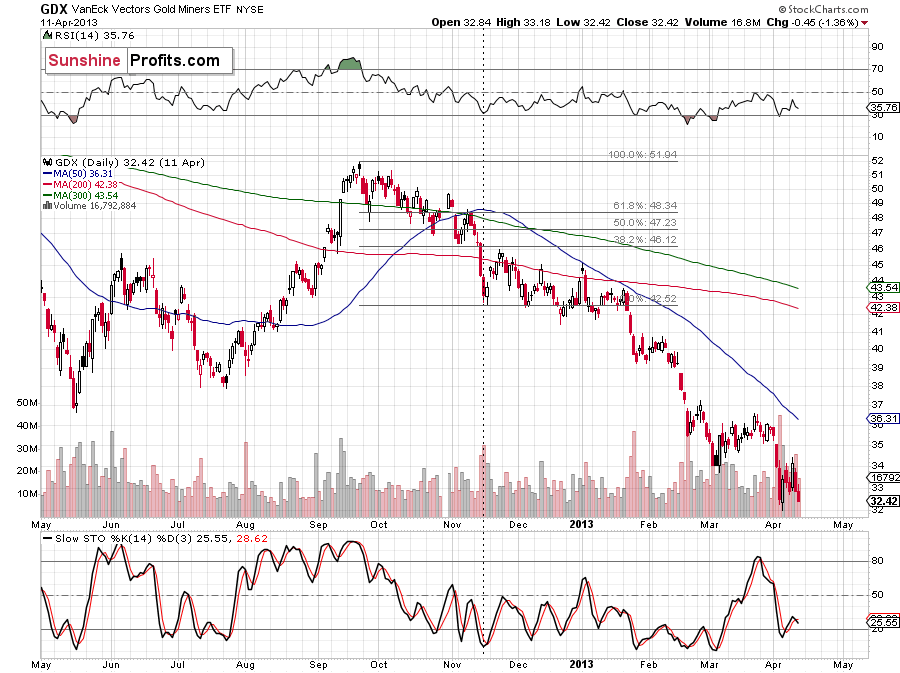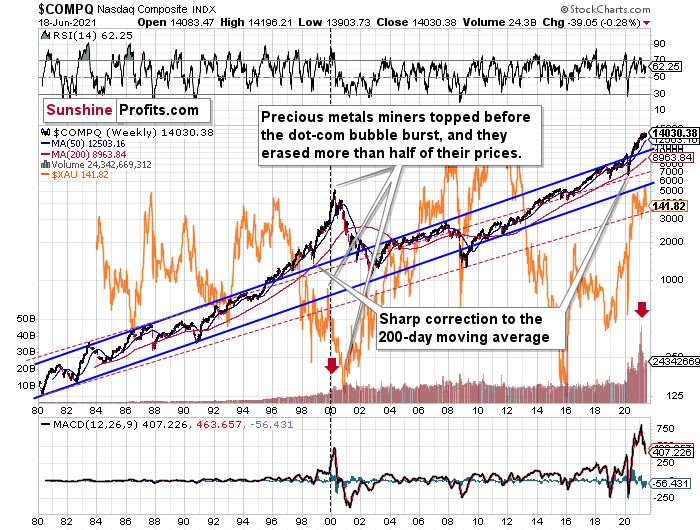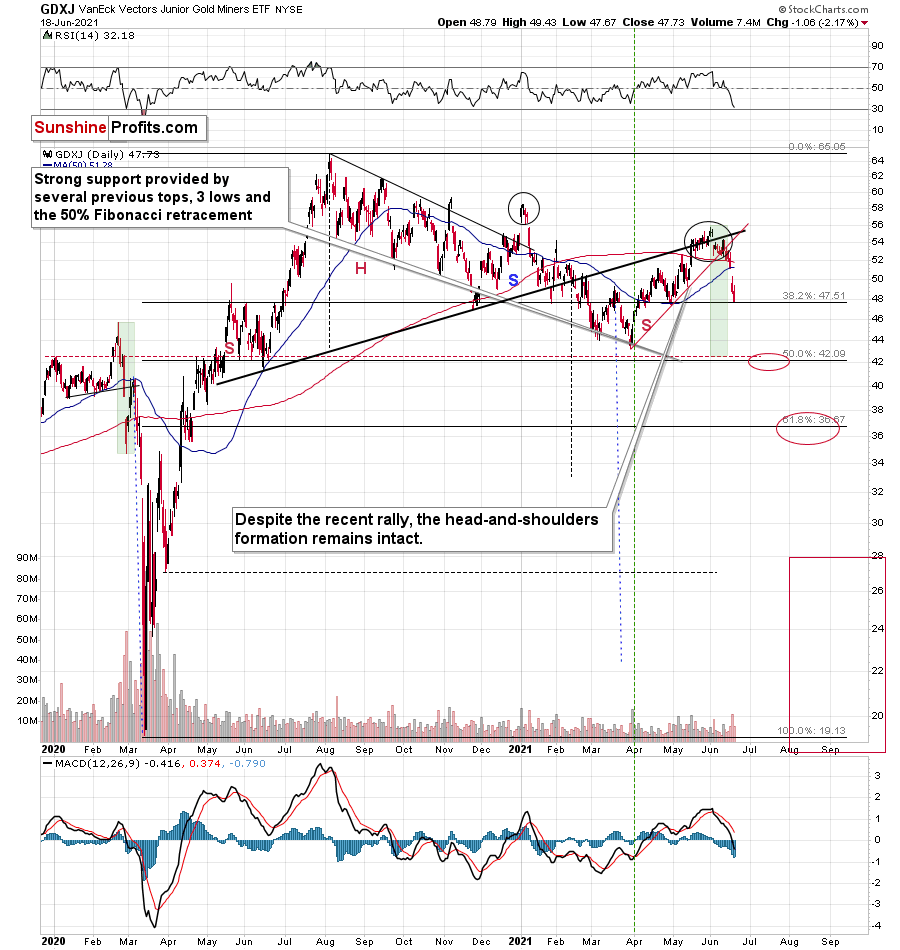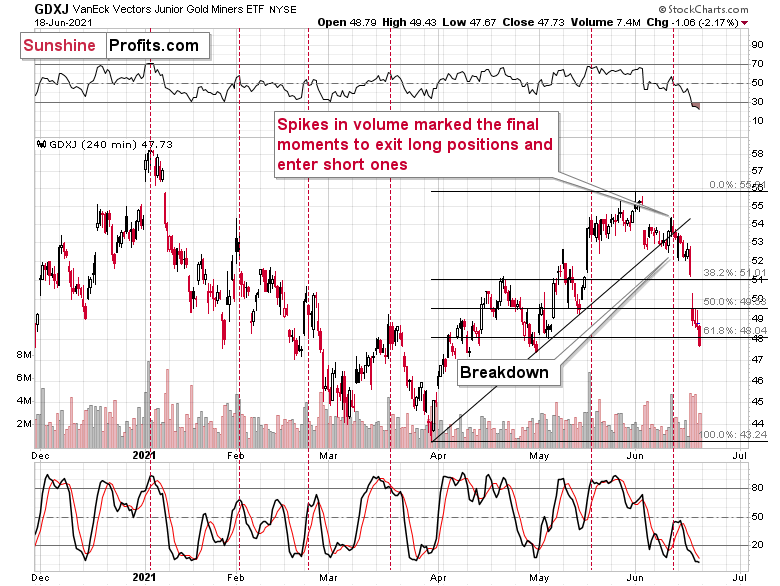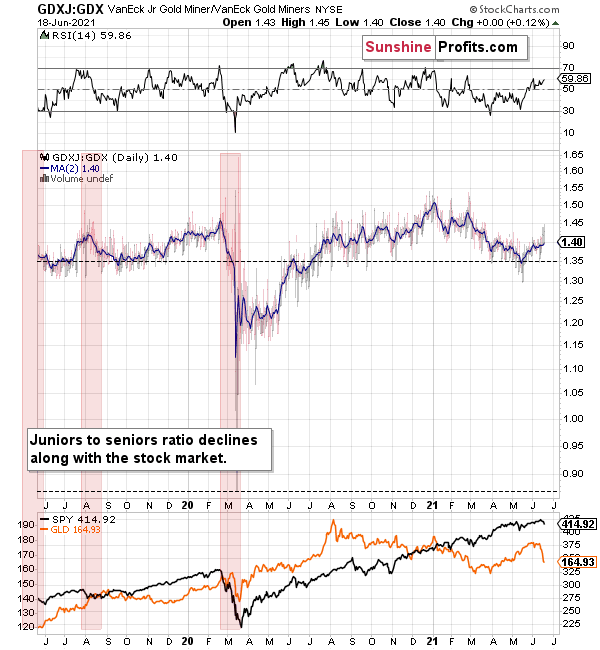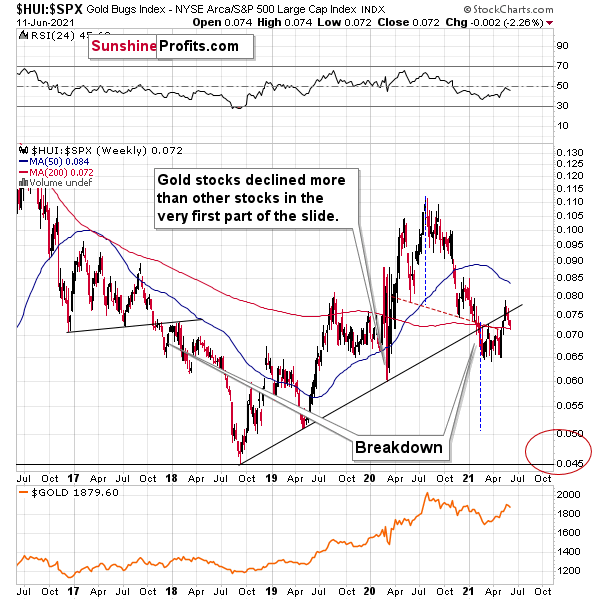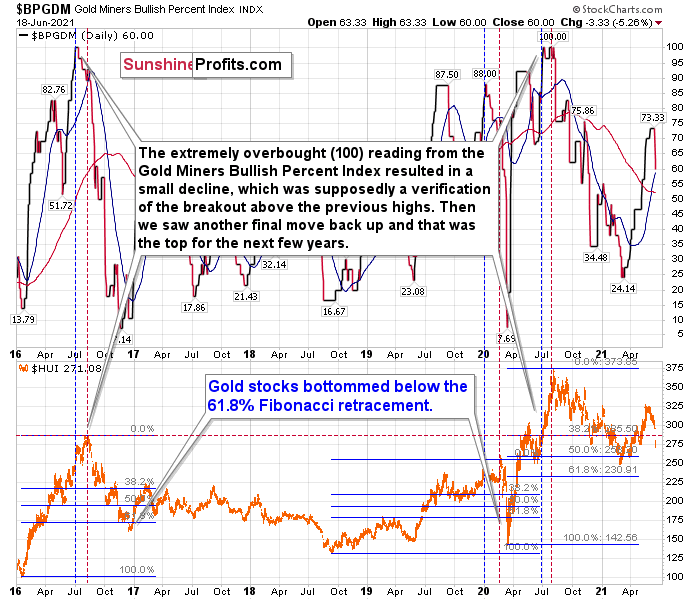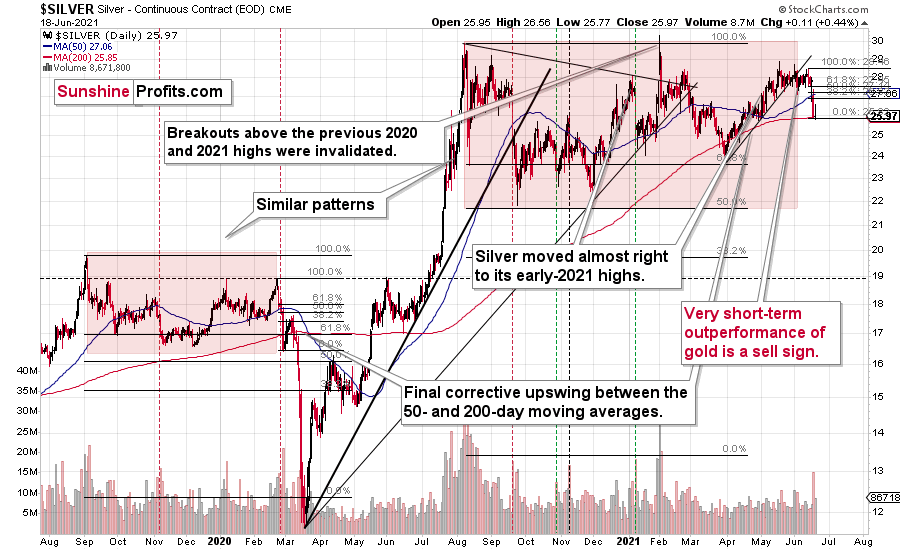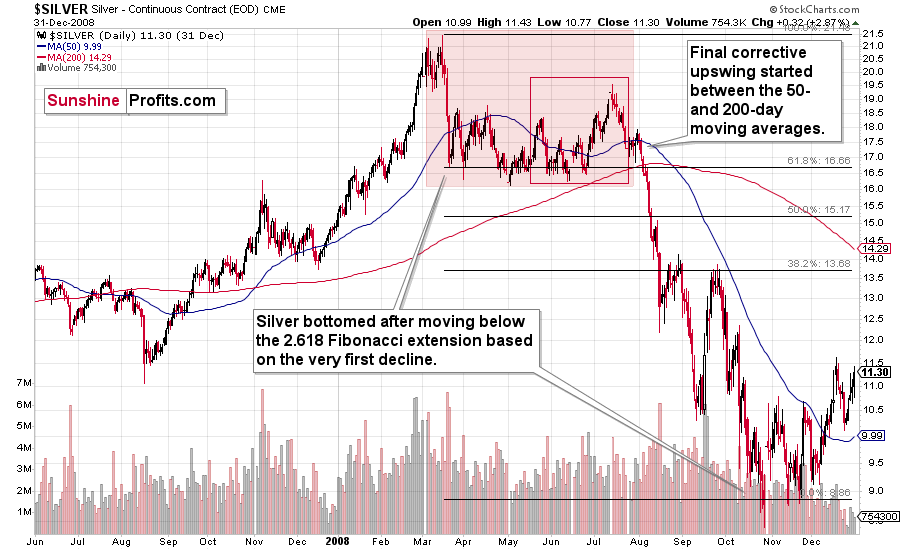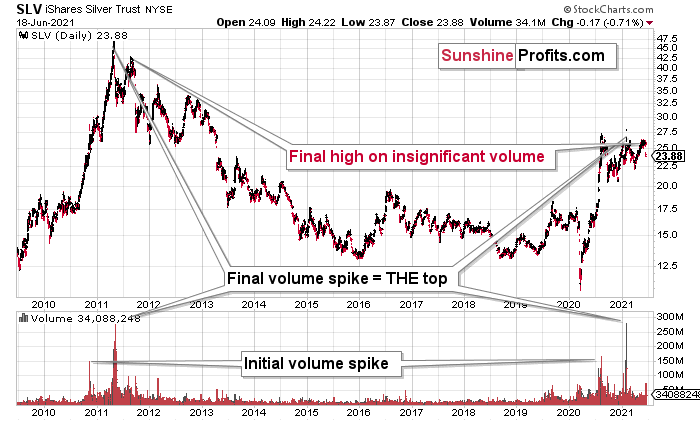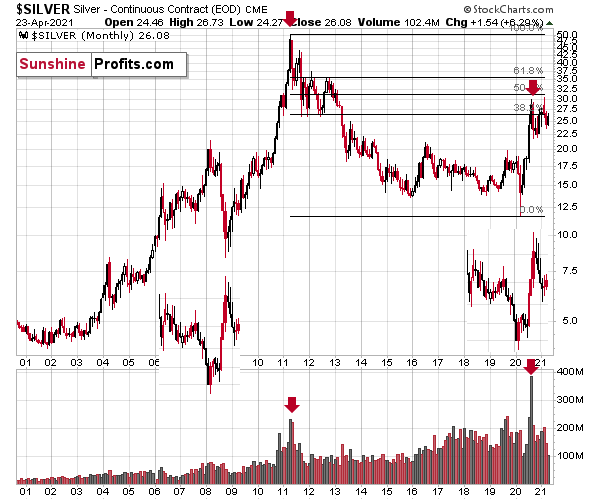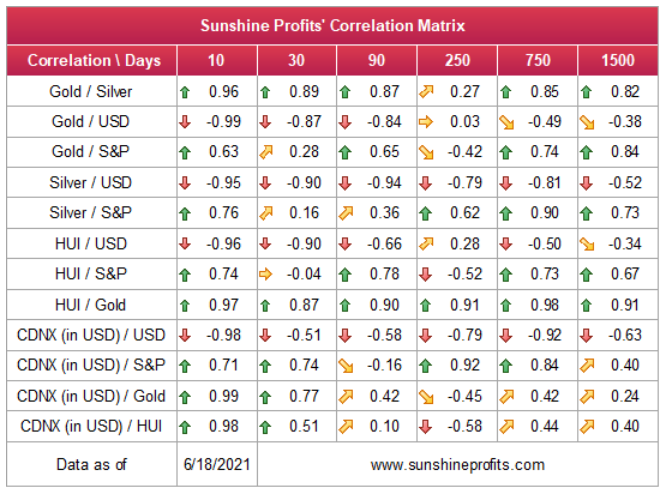Briefly: gold and the rest of the precious metals market are likely to decline in the next several weeks/months and then start another powerful rally. Gold’s strong bullish reversal/rally despite the USD Index’s continuous strength will likely be the signal that confirms that the bottom is in.
Welcome to this week's Gold Investment Update. Predicated on last week’s price moves, our most recently featured outlook remains the same as the price moves align with our expectations. On that account, there are parts of the previous analysis that didn’t change at all in the earlier days, which will be written in italics.
Let’s start with a quick review of the key fundamental news that hit the market last week and served as a direct trigger for the storm that was brewing for a long time – the change in the Fed’s approach.
The Fed’s Stance Slowly Changes
In short, the recent Fed’s hawkish turn is fundamentally negative for gold prices, and it perfectly fits the technicals, which were practically screaming beforehand that the precious metals market was about to slide in the following weeks and months. However, it won’t stop the golden bull in the long run.
The hawkish counter-revolution within the Fed continues. On Friday, St. Louis Fed President James Bullard said that the recent FOMC shift towards a faster tightening of monetary policy was a natural response to faster economic growth and higher inflation than anticipated:
We were expecting a good year, a good reopening, but this is a bigger year than we were expecting, more inflation than we were expecting, and I think it's natural that we've tilted a little bit more hawkish here to contain inflationary pressures.
Bullard also noted that “Powell officially opened the taper discussion this week”.
In his prepared remarks for the press conference, Powell said:
At our meeting that concluded earlier today, the Committee had a discussion on the progress made toward our goals since the Committee adopted its asset purchase guidance last December. While reaching the standard of “substantial further progress” is still a way off, participants expect that progress will continue. In coming meetings, the Committee will continue to assess the economy’s progress toward our goals. As we have said, we will provide advance notice before announcing any decision to make changes to our purchases.
In plain English, it means that the Fed could announce tapering at any of its future meetings, depending on the assessment of the incoming data. However, to avoid a replay of the taper tantrum, the Fed will “give advance notice before announcing any decision”. So, September is the first probable date of a hawkish announcement about tapering of quantitative easing, which could be preceded by some clues as early as in July:
That is, you know, the process that we're beginning now at the next meeting. We will begin, meeting by meeting, to assess that progress and talk about what we think we're seeing, and just do all of the things that you do to sort of clarify your thinking around the process of deciding whether and how to adjust the pace and composition of asset purchases.
Another hawkish shift in the Fed’s thinking, which is worth pointing out, is that it dropped the phrase in the statement saying that the pandemic is weighing on the economy. So, although it’s still cited as a risk, Powell and his colleagues officially ceased to see the pandemic as a constraint on economic activity. It means that, as I already wrote earlier in my reports, the US economy has returned to the pre-epidemic level, or has shifted from the recovery to the expansion phase.
What does it all mean for the yellow metal? Well, the Fed triggered some panic selling in the gold market last week. Actually, on Thursday, there was the largest one-drop of 2021 in response to the more hawkish stance of the US central bank, as the chart below shows.
The bearish reaction is understandable, as the Fed’s readiness to reduce its asset purchases and end the policy of zero interest rates is fundamentally negative for the yellow metal. More hawkish FOMC implies higher real interest rates and a stronger dollar, the two most important drivers of gold prices. Furthermore, when the US central bank becomes more hawkish, it means that it’s more confident in the economy – and gold struggles when the economy is strong.
As always, some analysts claim that the selloff was exaggerated. After all, the Fed still maintains that higher inflation is transitory; but transitory inflation doesn’t mix with earlier interest rate hikes. So, we will have either more lasting high inflation (but the Fed is slow to admit it), or the Fed doesn’t really want to increase its interest rates substantially. In both cases, gold should benefit, either from higher inflation and lower real interest rates or from more dovish Fed than it’s currently perceived. It seems most likely to me that the bullish benefits will take place in the long run, not in the next few months.
So, overall, the long-term bullish case for gold is not dead yet, but if the Fed really becomes more hawkish and determined to tighten its monetary policy (while high inflation turns out to be transitory), gold may struggle during the upcoming tightening cycle, unless it triggers some economic turmoil.
The analogies to the past and technical analysis in general tell us how things are likely to develop because history tends to rhyme, even though no day is identical. Sure, the economic picture changes a lot from year to year and from decade to decade, but people continue to be greedy and fearful and react to similar events (causing similar emotions) in similar ways. Consequently, history does rhyme indeed.
In this case, it seems that stocks will slide and that PMs are going to decline along with them. Furthermore, it seems that mining stocks will be hit the most, especially initially. Theoretically, when stocks collapse, people should want to buy gold, silver and mining stocks – the safe havens or assets related to them. However, in the short run, the flight to cash prevails as investors seek liquidity and just want “out”. What is very interesting, there is a general tendency for situations like this to develop in similar ways. Once the stock market tops, the countdown starts, and then the precious metals market bottoms about 3 – 3.5 months thereafter. It seems that it’s the amount of time that investors need to digest the news and turn to the precious metals market for protection.
Why is it taking so long? Nobody knows. It’s just how things seem to work. Just as with the Pareto principle that is not based on any specific theory, but rather on myriads of observations – 20% of effort generates 80% of outcome and so on. Fortunately, we don’t need to know why the above works in order to take advantage of it.
And if the general stock market has just topped, then the next 3-4 months are likely to generate many lasting memories. And a ton of profits – at least to those positioned to take advantage of the above.
Medium-Term Implications for Gold
With the Fed’s announcement turning the financial markets upside down, the U.S. 10-Year Treasury yield’s rollercoaster performance didn’t capture the magnitude of the move. For example, with the front-end of the U.S. yield curve becoming increasingly unhinged, the U.S. 2-Year, 3-Year and 5-Year Treasury yields surged by more than 62%, 38% and 12% respectively following the Fed’s announcement.
Please see below:
Speaking of the U.S. 10-Year Treasury yield, with historical imbalances magnified across the U.S. Treasury market, on a relative basis, the U.S. 10-Year Treasury yield is trading at or near an all-time low. To explain, the Treasury benchmark still demonstrates its largest-ever divergence from the U.S. 10-Year breakeven inflation rate.
Please see below:
More importantly, though, if another explosion erupts in the bond market, the yellow metal will likely be buried under the rubble.
To explain, I wrote on May 11:
The gold line above tracks the London Bullion Market Association (LBMA) Gold Price, while the red line above tracks the inverted U.S. 10-Year real yield. For context, inverted means that the latter’s scale is flipped upside down and that a rising red line represents a falling U.S. 10-Year real yield, while a falling red line represents a rising U.S. 10-Year real yield.
If you analyze the left side of the chart, you can see that when the U.S. 10-Year Treasury yield began its move to reconnect with the U.S. 10-Year breakeven inflation rate in 2013 (taper tantrum), the U.S. 10-Year real yield surged (depicted by the red line moving sharply lower). More importantly, though, amidst the chaos, gold plunged by more than $500 in less than six months.
Over the medium-to-long term, the copper/U.S. 10-Year Treasury yield ratio is also a leading indicator of gold’s future behavior.
I wrote previously:
When the copper/U.S. 10-Year Treasury yield ratio is rising (meaning that copper prices are rising at a faster pace than the U.S. 10-Year Treasury yield), it usually results in higher gold prices. Conversely, when the copper/U.S. 10-Year Treasury yield ratio is falling (meaning that the U.S. 10-Year Treasury yield is rising at a faster pace than copper prices), it usually results in lower gold prices.
If you analyze the chart below, you can see the close connection:
And after attempting, and failing, to maintain the material divergence, gold made a mad dash toward the red line last week. What’s more, the copper/U.S. 10-Year Treasury yield ratio still signals a gold price of roughly $1,690.
Please see below:
What About Copper?
I mentioned previously that with China’s manufacturing PMI (new orders) beginning to roll over, copper’s recent momentum could be ripe for a reversal. And with the bronze metal plunging by 8.39% last week, if further weakness persists, the copper/U.S. 10-Year Treasury yield ratio could head even lower over the medium term.
To explain, the blue line above tracks the year-over-year (YoY) percentage change in copper, while the gray line above tracks China’s manufacturing PMI (new orders). If you analyze the right side of the chart, you can see that investors priced in the highest Chinese demand in more than 10 years.
The bottom line?
With the copper/U.S. 10-Year Treasury yield ratio highly correlated with the yellow metal, copper’s rocket ship helped lift gold above $1,900. However, with the momentum sputtering, gold has already suffered a hard landing.
Also, do you remember what I wrote about copper on June 9?
I wrote the following:
Namely, copper has just invalidated its breakout to new highs, which means that – just like in the case of gold in August 2020 – it wasn’t strong enough to soar higher. Well, it’s not to say that copper is weak, as it has more than doubled its price since the 2020 lows. However, it does mean that it’s likely time for a bigger corrective downswing, especially given that we haven’t seen one in many months. For instance, when gold invalidated its breakout above the 2011 high despite very bullish fundamentals, it meant that forecasting gold at lower levels was very much justified.
Likewise, when copper failed to hold its breakout above the 2008 high back in 2011, it was followed by a multi-year decline. Will the same happen this time? I wouldn’t bet on that given the amount of money being pumped into the system, but even if this is not the case, copper is likely to suffer a significant drawdown on a temporary basis. No market can move up or down in a straight line, and neither copper nor gold nor silver are exceptions to this rule.
Ok, but why is it important for the precious metals investors?
Because of two things:
- Both markets tend to move in a big way at similar times. The more local moves can vary, but the really big price moves are usually aligned. For example, the 2008 – 2011 rally and the fact that they both bottomed in late-2015 / early-2016.
- The copper price is quite closely related to the general stock market and the former’s inability to hold above its previous highs seems to be an indication of a change in the trend in the general stock market as well.
And indeed, copper declined substantially – over 8% last week.
Finally, while U.S. equities endured material weakness on Jun. 18, the S&P GSCI (the commodity index) actually rose by 0.88%. And with the index moving in near-lockstep with the U.S. 10-Year Treasury yield since 2015, a reversal of the imbalance could increase the PMs’ troubles over the medium term.
On the flip side, if we extend our time horizon, there are plenty of fundamental reasons why gold is likely to soar in the coming years. However, even the most profound bull markets don’t move up in a straight line, and corrections are inevitable.
As it relates to the precious metals, a significant correction (medium-term downtrend) is already underway. However, the pain is not over, and a severe climax likely awaits.
For context, potential triggers are not always noticeable, and the PMs may collapse on their own or as a result of some random trigger that normally wouldn’t cause any major action. However, a trigger will speed things up, and that’s where the S&P 500 comes in:
Stock Market Signals
While the NASDAQ Composite’s futures contract hit a new all-time high, the index itself wasn’t able to achieve the illustrious milestone. As a result, we may have already witnessed the top for Big Tech.
Please see below:
As further evidence, the S&P 500 invalidated the breakouts above its daily and weekly highs on relatively strong volume. What’s more, the shape and the magnitude of the S&P 500’s RSI (Relative Strength Index) are mirroring the behavior that we witnessed in late 2019/early 2020 and the double-top in the S&P 500’s RSI was also present in 2018. As a result, the implications are profoundly bearish and U.S. equities are likely headed for a significant slide.
Please see below:
And why should we – precious metals investors and traders – be concerned with the performance of stocks? Because when stocks finally top and start to decline, it will likely make the decline in the precious metals market much more severe. For one, identical developments occurred in 2008, 2020 and 1929. Second, the precious metals often bottom about 3 – 3.5 months after the top in the general stock market. Third, the S&P 500’s 2020 analogue is becoming even more valid by the day.
To explain, I wrote the following on Wednesday (Jun. 9):
The markets are self-similar (which is another way of saying that they have a fractal nature), which generally means that while the history tends to rhyme, it also tends to rhyme in similar shapes of alike or various sizes.
For example, the rally from 2018–2020 seems very similar to the rally from 2020 to the present. Both rallies started after a sharp decline, and the first notable correction took the form of back-and-forth trading around the previous high. I marked those situations with big rectangles.
Then the rally continued with relatively small week-to-week volatility. I created rising support lines based on the final low of the broad short-term consolidation and the first notable short-term bottom.
This line was broken, and some back-and-forth trading followed, but it was only about half of the previous correction in terms of price and time.
Then, we saw a sharp rally that then leveled off. And that was the top. The thing that confirmed the top was the visible breakdown below the rising support line right after stocks invalidated a tiny breakout to new highs. That’s what happened in February 2020, and that’s what seems to be taking place right now.
Back in 2020, the rally ended when the weekly RSI moved above 70 once again and when the S&P moved slightly to its new highs. While the history doesn’t have to repeat itself to the letter, if we see another small move higher – to new highs – that also takes the RSI above 70, please keep in mind that it’s not really a bullish development, but actually history forming its final rhyme. And the implications appear bearish for the precious metals sector, as it’s likely to be hit by the first wave of stock market declines – just like it was the case in 2008, 2020, and… 1929.
The bottom line?
It seems that history is indeed forming its final rhyme. However, can we start the 3-3.5-month countdown now? Well, while timing remains uncertain, the main drivers of the stock market’s success are beginning to sputter. With inflation running hot and employment likely to surge in the coming months (once enhanced unemployment benefits expire), all of the boxes should be checked for the FED to taper its asset purchases. And with investors largely averse to a reduction in liquidity, the outcome could have a profound impact on both the general stock market and the PMs.
Keep in mind though: a decline in stocks is not required for the PMs to decline. But a break in the former could easily trigger a sell-off in the latter, and if history decides to rhyme again, silver and the miners will be the hardest hit.
The USD Index (USDX)
While investors have been prophesying the ‘death of the dollar’ for some time now, the USD Index rose from the ashes last week. And while the magnitude of the move and the USDX’s RSI jumping above 70 signals that a short-term cooling-off period could ensue, a similar rally occurred in early 2020 and the USD Index maintained its momentum until the RSI approached 80.
In addition, given the breakout above the 61.8% Fibonacci retracement level, the USD Index may continue its ascent and rise above its declining blue resistance line and attempt to reclaim its April highs. If this occurs, the USDX will complete its inverse head & shoulders pattern and cement its bullish legacy for the following weeks/months. For context, completion of the milestone implies a short-term target of roughly 98.
As for the medium term, material upswings often start close to the middle of the year. If you analyze the chart below, you can see that summertime surges have been mainstays on the USD Index’s historical record. If that wasn’t enough, double bottoms often signal the end of major declines and often ignite significant rallies. For example, in 2004, 2005, 2008, 2011, 2014 and 2018, a retest of the lows (or close to it) occurred before the USD Index began its upward flights. Finally, back in 2008, U.S. equities’ plight added even more wind to the USD Index’s sails. And if the general stock market suffers another profound decline, a sharp re-rating of the USDX is likely in the cards.
Please see below (quick reminder: you can click on the chart to enlarge it):
On top of that, the thesis is also supported by the USD Index’s long-term chart. To explain, the USDX’s long-term breakout remains intact, and if we steady the binoculars, the greenback’s uptrend is clearly in place.
Please see below:
Moving on to the Euro Index, the recent symmetrical decline mirrors the drawdown that we witnessed in mid-2020. And if the Euro Index breaks below the neckline of its bearish head & shoulders pattern, the slide could be fast and furious. For context, completion of the right shoulder signals a decline to (roughly) the June 2020 lows or even lower.
Please see below:
Furthermore, the completion of the masterpiece could have a profound impact on gold, silver and mining stocks. To explain, gold continues to underperform the euro. If you analyze the bottom half of the chart above, you can see that material upswings in the Euro Index have resulted in diminishing marginal returns for the yellow metal. Thus, the relative weakness is an ominous sign. That’s another point for the bearish price prediction for gold.
Also, signaling dollar strength, the USD Index has hopped into the time machine and set the dial to 2016. And with the flashback eliciting memories of past glory, a reenactment of the analogue likely won’t be applauded by the PMs.
As you can see on the above chart, what we saw this year was quite similar to what happened in 2016. The analogy that I described previously worked just like in the past. Namely, the back-and-forth movement after the breakout was followed by a quick rally.
The bottom line?
Once the momentum unfolds, ~94.5 is likely the USD Index’s first stop. In the months to follow, the USDX will likely exceed 100 at some point over the medium or long term. Keep in mind though: we’re not bullish on the greenback because of the U.S.’ absolute outperformance. It’s because the region is outperforming the Eurozone and the EUR/USD accounts for nearly 58% of the movement of the USD Index – the relative performance is what really matters.
The NASDAQ 100
As a secondary catalyst, a material drawdown of the NASDAQ 100 could eventually rattle U.S. equities.
Please see below:
To that point, given the USDX’s strong negative correlation with the NASDAQ 100, a material reset could propel the greenback back to its March highs. Moreover, following a short-term consolidation, the USDX could even exceed those previous highs.
Furthermore, relative outprinting by the European Central Bank (ECB) remains of critical importance. Last week, the FED/ECB ratio increased by 1.13%, while the EUR/USD decreased by 2.03%. And given that the ratio has declined by nearly 18% since May 2020, the EUR/USD still has some catching up to do.
Please see below:
The key takeaway?
With the ECB injecting more liquidity to support an underperforming Eurozone economy, the FED/ECB ratio, as well as EUR/USD, should move lower over the medium term. More importantly, though, because the EUR/USD accounts for nearly 58% of the movement of the USD Index, EUR/USD pain will be the USDX’s gain.
In addition, the top in the FED/ECB total assets ratio preceded the slide in the EUR/USD less than a decade ago, and it seems to be preceding the next slide as well. If the USD Index was to repeat its 2014-2015 rally from the recent lows, it would rally to 114. This level is much more realistic than most market participants would agree on.
As another ominous sign for the currency pair, the University of Michigan’s Consumer Sentiment Index (CSI) – released on Jun. 11 – rose from 82.9 in May to 86.4 in June and came in above the consensus estimate of 84. And with the CSI a reliable long-term indicator of the EUR/USD’s future value, the print stuck another fundamental dagger into the heart of the euro.
Please see below:
For context, I wrote on May 19:
The red line above tracks the EUR/USD, while the green line above tracks the inverted University of Michigan’s CSI. For context, inverted means that the latter’s scale is flipped upside down and that a rising green line represents a falling CSI, while a falling green line represents a rising CSI. More importantly, though, if you analyze the relationship, you can see that troughs in the CSI nearly always coincide with peaks in the EUR/USD. Moreover, while both variables had risen simultaneously, the EUR/USD is fighting a battle that it hasn’t won in 40+ years.
Very Long-Term Indications for Gold
Following the roadmaps that I laid out, gold’s behavior is mirroring the analogies from 2008 and 2012.
To explain, I wrote previously:
With the month of May now on the books, the MACD indicator is still flashing red. And despite gold’s recent strength and all of the attention that has come with it, the MACD indicator has barely flinched. Furthermore, while a slight pause in the MACD indicator’s downtrend is clearly visible, an identical development also occurred in mid-2012. And what happened then? Well, if you analyze the chart below, you can see that gold’s joy quickly turned into sadness, and the yellow metal suffered a profound decline.
Even eerier, the MACD indicator’s recent pause has occurred at a level that also mirrors the analogue from 2012. And what happened back then? The yellow metal plunged by more than $600 before the bottom was finally reached. Likewise, the current position of the MACD indicator is also symmetrical to the 2008 top. And back then – during the Global Financial Crisis (GFC) – the yellow metal plunged by more than $334 from peak to trough (over 30%).
While short-term price movements often garner the most attention, it’s important to remember that gold’s long-term downtrend is also reminiscent of the second half of 2012. If you analyze the middle-right area of the chart below, you can see that the MACD indicator sounded the alarm in 2012. And while investors ignored the warning and gold moved higher, a profound plunge followed in 2013. Moreover, while the MACD indicator’s sell-signal was visible throughout gold’s entire journey – despite several ebbs and flows in the price action – the narrowing distance between the black and red lines actually preceded gold’s plunge. Thus, with gold’s swan song beginning to play at nearly the same level in 2013, the yellow metal’s recent strength is likely only the intermission.
The above-mentioned narrowing distance between the MACD lines can be seen clearly seen through the blue bars hovering around the 0 level on the indicator part of the chart. We now see the current blue bar move toward 0. We saw the same thing in the second half of 2012, which is when gold rallied for the last time before the huge slide.
Remember the huge gap between the U.S. 10-Year Treasury yield and the U.S. 10-Year breakeven inflation rate? The situation in the very long-term MACD indicator is yet another confirmation that what we saw recently is similar to what we saw before the huge 2012 – 2013 slide. We get the same confirmation from the gold to bonds ratio, and I’ll move to that a bit later.
Based on gold’s previous performance after the major sell signals from the MACD indicator, one could now expect gold to bottom in the ~$1,200 to ~1,350 range. Given the price moves that we witnessed in 1988, 2008 and 2011, historical precedent implies gold forming a bottom in this range. However, due to the competing impact of several different variables, it’s possible that the yellow metal could receive the key support at a higher level.
Considering the reliability of the MACD indicator as a sell signal for major declines, the reading also implies that gold’s downtrend could last longer and be more severe than originally thought. As a result, $1,500 remains the most likely outcome, with $1,350 still in the cards.
Circling back to the Global Financial Crisis (GFC), if you focus your attention on the monthly price action in 2008, epic volatility coincided with the yellow metal’s fall from grace. Conversely, in 2012, gold’s initial decline was relatively muted before the climax unfolded. As a result, whether the yellow metal runs or walks toward its medium-term demise, last week’s price action was perfectly normal given the historical similarities. Namely, the volatility was significant but not as extreme as in 2008.
Please see below:
To explain, after making a new all-time high in 2008 (that was a breakout above the 1980 tops), gold declined back to its rising support line before recording a short-term corrective upswing. This upswing ended approximately at gold’s previous monthly closing price. I marked it with a horizontal, blue, dashed line.
Similarly, if you analyze the right side of the chart, you can see that an identical pattern has emerged. With gold’s corrective upswing following a reconnection with its rising support line, history implies that a sharp decline should occur in the coming months and that the reversal is at hand or already behind us. After all, the thing that triggered the decline almost a year ago was the fact that gold made a new all-time high. Moreover, the recent high was very close to the previous high in terms of the monthly closing prices (Dec. 2020 - $1,895.10 vs. the recent intraday high of $1,915.60).
In addition, when we zoom in on the weekly chart, the 2012 analogue is even more valid. Whether it’s the RSI indicator, the MACD indicator or the overall price action, the readings are profoundly similar and the bearish implications remain intact.
To explain, I wrote previously:
If you analyze the long-term chart below, you can see that gold has invalidated the breakout above its 2011 high. More importantly, though, with its rising support line (on the right side of the chart) also coinciding with the 61.8% Fibonacci retracement level and the 2019 and 2020 lows, ~$1,450 to $1,500 is the most prudent medium-term price target.
Conversely, if the 2008 analogue repeats – and a crisis of confidence erupts across U.S. equities – the PMs could move substantially lower. When combining an equity shock with an USD Index’s resurgence, the yellow metal could bottom at roughly $1,400 (or even ~$1,350). Similarly, while the MACD indicator (on gold’s 40-year chart near the top of today’s edition) signals a bottom in the ~$1,200 to ~1,350 range, to be perfectly clear, ~$1,450 to $1,500 is the most likely outcome.
If you analyze the red arrow in the lower part of the above chart (the weekly MACD sell signal), today’s pattern is similar not only to what we saw in 2011, but also to what we witnessed in 2008. Thus, if similar events unfold – with the S&P 500 falling and the USD Index rising (both seem likely for the following months, even if these moves don’t start right away) – the yellow metal could plunge to below $1,350 or so. The green dashed line shows what would have happened to the gold price if it had not declined as much as it did in 2008.
In addition, relative to 2011-2013, today’s price action is also a splitting image. For starters, gold invalidated the breakout above its 2011 highs. Invalidations of breakouts are sell signals, and it’s tough to imagine a more profound breakout that could have failed.
Furthermore, if you analyze the right side of the chart above (the bottom section), you can see that the MACD indicator has sprouted a tiny weekly buy signal. However, it’s important to remember that the same signal emerged in mid-2008 – which confirmed the previous rally but had no bullish implications for the future. Case in point: following the reading in 2008, gold’s volatility increased, and the yellow metal suffered several declines before finding a lasting bottom in 2009. Thus, the recent reading is nothing to write home about. I marked both cases with red, dashed lines.
If that wasn’t enough, the gold/ Dow Jones Corporate Bond Index (Total Return) ratio has fallen below its rising support line. And when this occurred in 2012, the most violent part of gold’s decline was already underway.
Please see below:
To explain, if you analyze the middle of the chart above, you can see that the ratio recorded a countered rally, jumped back above its rising support line and 50-week moving average and then… collapsed. And with a similar pattern forming on the right side of the chart, the ratio is looking more and more like a widow-maker. Furthermore, when factoring in mining stocks’ bearish H&S patterns, the fundamental headwinds confronting gold and the strong likelihood of a medium-term swoon in the stock market, you can already hear the yellow metal’s death knell tolling in the distance.
Gold’s Short-and-Medium-Term Outlook
After gold plunged by more than $100 last week, two bullish factors emerged from the wreckage:
- Thursday’s (Jun. 17) decline took place on huge volume.
- The decline caused the RSI indicator to go slightly below 30, which is a classic buy signal.
Moreover, while the milestones haven’t been reached, gold moved relatively close to its late-April bottom and its rising medium-term support line. Both levels are very close to the $1,750 level, which is also quite a round number, which sometimes makes a difference (it’s significant from the psychological point of view). What’s more, gold’s RSI – which I marked with the dotted green lines below – also moved to the 30 level following declines in late November and late February. In one case, it marked the bottom and in the second case it was relatively close to the bottom but not yet at it.
Please see below:
And what can we learn from the prior bouts of volatility? That gold might correct from here, but it seems more likely that it will decline a bit more before it does. Why? Because of the analogy to late February. That’s when we saw both: the RSI at 30 and a volume spike, which makes this situation more similar to the late-November one when the spike in volume was rather absent. So, based on the above chart, while we might see a bounce soon, it seems more likely that it will be from around $1,750.
And how does all of this line up with the 2012-2013 roadmap? For context, I’m excluding the 2008 analogy here because the level of volatility during the GFC has yet to materialize across the financial markets. However, based on what happened in 2012, once the RSI hit 30 in November, the first part of the huge decline was over. As a result, it seems that gold is likely to correct upwards right away Also, please note that the chart ends where a really huge decline starts, so the real follow-up is much more bearish than it seems based on the chart alone.
Please see below:
Moreover, please note that gold’s corrective upswing occurred when it moved close to its previous short-term (August) high. Thus, with gold already falling slightly below its April 2021 highs on Jun. 18, given the similarity of both situations, gold seems ready to rally right away.
But how strong was the corrective upswing in 2012 before the yellow metal resumed its downtrend? Well, it corrected 61.8% of its previous decline and that would align with a rally to ~$1,860 while still preserving the medium-term downtrend. Now, that would be quite a substantial rally, so not something that those shorting gold might want to endure without closing the position temporarily. We’re not shorting gold, only mining stocks, but if you’re shorting gold, it might be a good idea to consider temporarily exiting or limiting the short position soon.
For more on the 2008 and 2012 analogies, I wrote on Jun. 4:
The analogies to how the situation in gold developed in 2008 and 2012, provides us with an extremely bearish price prediction for gold. Many other factors are pointing to these similarities, and two of them are the size of the correction relative to the preceding decline and to the previous rally. In 2012 and 2008, gold corrected to approximately the 61.8% Fibonacci retracement level. Gold was very close to this level this year, and since the history tends to rhyme more than it tends to repeat itself to the letter, it seems that the top might already be in.
In both years, 2008 and 2012, there were three tops. Furthermore, the rallies that took gold to the second and third top were similar. In 2008, the rally preceding the third top was bigger than the rally preceding the second top. In 2012, they were more or less equal. I marked those rallies with blue lines in the above chart – the current situation is very much in between the above-mentioned situations. Also, the current rally is bigger than the one that ended in early January 2021 but not significantly so.
Remember what happened when gold previously attempted to break above major long-term highs? It was in 2008 and gold was breaking above its 1980 high. Gold wasn’t ready to truly continue its bull market without plunging first. This downswing was truly epic, especially in the case of silver and mining stocks; and now even gold’s price patterns are like what we saw in 2008.
My previous comments on the analogies to 2008 and 2012 remain up-to-date:
Back in 2008, gold corrected to 61.8% Fibonacci retracement, but it stopped rallying approximately when the USD Index started to rally, and the general stock market accelerated its decline.
Taking into consideration that the general stock market has probably just topped, and the USD Index is about to rally, then gold is likely to slide for the final time in the following weeks/months. Both above-mentioned markets support this bearish scenario and so do the self-similar patterns in terms of gold price itself.
Moreover, while the pace of gold’s decline in 2012 started off slow, the momentum picked up later on as the drawdown became even more vicious.
Please see below:
The relatively broad bottom with higher lows is what preceded both final short-term rallies – the current one, and the 2012 one. Their shape as well as the shape of the decline that preceded these broad bottoms is very similar. In both cases, the preceding decline had some back-and-forth trading in its middle, and the final rally picked up pace after breaking above the initial short-term high.
Interestingly, the 2012 rally ended on huge volume, which is exactly what we saw also on May 19 this year. Consequently, forecasting much higher silver or gold prices here doesn’t seem to be justified based on the historical analogies.
The thing I would like to emphasize here is that gold didn’t form the final top at the huge-volume reversal on Sep. 13, 2012. It moved back and forth for a while and moved a bit above that high-volume top, and only then the final top took place (in early October 2012).
The same happened in September and in October 2008. Gold reversed on huge volume in mid-September, and it was approximately the end of the rally. The final top, however, formed after some back-and-forth trading and a move slightly above the previous high.
Consequently, the fact that gold moved a bit above its own high-volume reversal (May 19, 2021) is not an invalidation of the analogy, but rather its continuation.
There’s one more thing I would like to add, and it’s that back in 2012, gold corrected to approximately the 61.8% Fibonacci retracement level – furthermore, the same happened in 2008 as you can see in the below chart. Consequently, the fact that gold moved above its 50% Fibonacci retracement doesn’t break the analogy either. And even if gold moves to $1,940 or so, it will not break it. It’s not likely that it is going to move that high, as in both cases –in 2008 and 2012 – gold moved only somewhat above its high-volume reversal before forming the final top. So, as this year’s huge-volume reversal took place close to the 50% retracement and not the 61.8% retracement, it seems that we’ll likely see a temporary move above it, which will create the final top. And that’s exactly what we see happening so far this week.
The lower part of the above chart shows how the USD Index and the general stock market performed when gold ended its late-2012 rally and was starting its epic decline. In short, that was when the USD Index bottomed, and when the general stock market topped.
Also, please note that while it might seem bullish that gold managed to rally above its declining black resistance line recently (the one based on the 2020 top and the 2021 top), please note that the same happened in 2012 – I marked the analogous line with red. The breakout didn’t prevent gold from sliding. When the price reached the line, we saw a short-term bounce, but nothing more than that – the gold price fell through it in the following weeks.
On top of that, with the Fed’s confidence game won or lost by whether or not inflation proves “transitory,” wouldn’t the central bank appreciate lower gold prices? If you think about it, it would be awfully convenient for the price of gold to decline in order to prove the point of the transitory nature of inflation.
Now, as you know, I’m not a fan of all the conspiracy theories that are out there, and I’m not the first to shout gold manipulation or silver manipulation every time the yellow or while metal goes down, but I also know that being realistic is one of my strengths. With the situation being what it is, and since the communities of top investment bankers and the community of officials interlace, I think that we have yet another reason to expect that the gold price is going to slide in the following weeks/months.
Finally, there are more layers to the analogue from 2008 that are extremely important.
Please see below:
Please note (in the lower part of the above chart) that back then, the final huge slide in the mining stocks started when the GDX ETF moved back to its previous highs, while the USD Index moved a bit below its rising support line based on the previous tops. That’s exactly what happened recently as well. The final bottom in the GDX ETF formed about 3 months later at about 1/3 of its starting price.
The recent high was $40.13 and 1/3 thereof would be $13.38. While I don’t want to say that we will definitely see the GDX ETF as low as that, it’s not something that would be out of the ordinary, given the analogy to 2008. Now you see why the large bottoming target on the GDX ETF chart with the lower border in the $15s might actually be conservative… As always, I’ll keep you – my subscribers – updated.
“Ok, but what price level would be likely to trigger a bigger rebound during the next big slide?”
Well, the 76.4% Fibonacci retracement level (it’s visible as the 23.6% Fibonacci retracement level on the above chart as inverting the scale is used as a workaround) also coincides with gold’s April 2020 low. Taken together, an interim bottom could form in the ~$1,575 to $1,600 range.
For context, back in early March, the yellow metal continued to decline after reaching the 61.8% Fibonacci retracement (visible as 38.2% Fibonacci retracement) level, while, in contrast, the miners began to consolidate. Gold finally bottomed slightly below the retracement – at its previous lows. This time around, we might witness a similar event. And while the story plays out, the miners’ relative strength should signal the end of the slide (perhaps with gold close to 1,600), while gold will likely garner support sometime thereafter (at $1,575 – $1,580 or so).
Remember though: this is only an interim target. Over the medium term, the yellow metal will likely form a lasting bottom in the ~$1,450 to $1,500 range.
The Gold Miners
While investors believed that superficial strength indicated clear skies ahead, I warned on Jun. 14 that storm clouds were likely to rain on gold, silver and mining stocks’ parade.
I wrote:
Not only has gold’s RSI fallen precipitously, but the yellow metal’s stochastic oscillator is also at levels that preceded significant historical drawdowns. As a result, while a $100+ decline is likely to materialize in the short term, an even larger decline will likely occur over the medium term. And with the 2008 and 2012-2013 analogues becoming even more valid by the day, gold’s ominous path forward will likely catch many market participants by surprise.
And with the technical realities finally drowning the yellow metal, it was a tough pill to swallow for those that didn’t heed the warning.
Please see below:
As part of the problem, the vast majority of individual investors and – sadly – quite many analysts focus on the trees while forgetting about the forest. However, once one zooms out and looks at the situation from a broad perspective, it’s clear that: “What has been will be again, what has been done will be done again; there is nothing new under the sun.” (-Ecclesiastes 1:9)
Therefore, while investors often focus all of their attention on the yellow metal, I warned on Jun. 14 that the HUI Index’s ominous behavior signaled significant downside for gold, silver and mining stocks.
I wrote:
With the HUI Index acting as the PMs’ canary in the coal mine, the bearish implications are as clear as day when eyeing the long-term chart. In the past three weeks, two key events unfolded:
- The stochastic oscillator delivered a clear sell signal.
- The self-similarity patterns became increasingly valid.
And with last week’s price action adding further confirmation, investors’ optimism is showing severe cracks in its foundation.
On top of that, even though the HUI Index plunged by more than 10% last week, the carnage may not be over. Case in point: the HUI Index is in the midst of forming the right shoulder of its bearish head & shoulders pattern, and if completed, could result in a profound decline over the medium term. For context, with gold approaching its late-April bottom and its rising medium-term support line, the yellow metal could bounce at roughly $1,750. In the process, the gold miners may follow suit. However, the bearish implications remain intact over the medium term, and a significant slide is likely to follow.
Please see below:
To explain, if you held firm in 2008 and 2013 and maintained your short positions, you almost certainly realized substantial profits. And while there are instances when it’s wise to exit one’s short positions and re-enter at more attractive prices, the smooth declines of gold, silver, and mining stocks mean that the risk-reward of doing so is tilted toward the downside. Or to put it more bluntly, the prospect of missing out on the forthcoming slide makes exiting the short positions a risky investment decision. For context, we believe that holding the short position is the most prudent course of action. However, if gold, silver and mining stocks become extremely oversold, we may consider covering on a short-term basis.
If that wasn’t enough, I warned previously that the recent plunge was weeks in the making:
I wrote the following about the week start started on May 24:
What happened three weeks ago was that gold rallied by almost $30 ($28.60) and at the same time, the HUI – a flagship proxy for gold stocks… Declined by 1.37. In other words, gold stocks completely ignored gold’s gains. That shows exceptional weakness on the weekly basis and is a very bearish sign for the following weeks.
To that point, the HUI Index is still following two medium-term historical analogies. To explain, back in 2008, right before a huge slide, in late September and early October gold was still moving to new intraday highs, but the HUI Index was ignoring that, and then it declined despite gold’s rally. However, it was also the case that the general stock market declined then. If stocks hadn’t declined back then so profoundly, gold stocks’ underperformance relative to gold would likely be present but more moderate.
Moreover, in 2012, the HUI Index topped on Sep. 21, and that was just the initial high in gold. At that time the S&P 500 was moving back and forth with lower highs – so a bit more bearish than the current back-and-forth movement in this stock index. And what was the eventual climax? Well, gold moved to new highs and formed the final top (Oct. 5). It was when the S&P 500 almost (!) moved to new highs, and despite both, the HUI Index didn’t move to new highs. Thus, the similarity to how the final counter-trend rally ended in 2012 (and to a smaller extent in 2008) ended is uncanny.
On top of that, the stochastic oscillator (which flashed a clear sell signal) is singing a similar tune. Not only do these signals often precede massive price declines on their own, but the analogies of 2008 and 2012 serve as confirmation that the huge decline has only just begun and that forecasting lower gold prices is currently justified.
Thus, if history rhymes, as it tends to, the HUI Index will likely decline profoundly and find medium-term support in the 100-to-150 range. For context, high-end 2020 support implies a move back to 150, while low-end 2015 support implies a move back to 100. And yes, it could really happen, even though it seems unthinkable.
For more on the 2008 and 2012 analogues, I wrote previously:
The HUI Index retraced a bit more than 61.8% of its downswing in 2008 and in between 50% and 61.8% of its downswing in 2012 before eventually rolling over. Now, in both (2008 and 2012) cases, the final top – the right shoulder – formed close to the price where the left shoulder topped. And in early 2020, the left shoulder topped at 303.02.
That’s why I previously wrote that “it wouldn’t be surprising to see a move to about 300 in the HUI Index”. And that’s exactly what we saw (a move above 320 is still close to 300 from the long-term point of view). To clarify, one head-and-shoulders pattern – with a rising neckline – was already completed, and one head-and-shoulders pattern – with a horizontal neckline – is being completed, but we’ll have the confirmation once miners break to new yearly lows.
Furthermore, three of the biggest declines in the mining stocks (I’m using the HUI Index as a proxy here), all started with broad, multi-month head-and-shoulders patterns. And in all three cases, the size of the declines exceeded the size of the head of the pattern.
As a result, we’re confronted with two bearish scenarios:
- If things develop as they did in 2000 and 2012-2013, gold stocks are likely to bottom close to their early 2020 high.
- If things develop like in 2008 (which might be the case, given the extremely high participation of the investment public in the stock market and other markets), gold stocks could re-test (or break slightly below) their 2016 low.
Keep in mind though: scenario #2 most likely requires equities to participate. In 2008 and 2020, the sharp drawdowns in the HUI Index coincided with significant drawdowns of the S&P 500. However, with the Fed turning hawkish and investors extremely allergic to higher interest rates, the likelihood of a three-peat remains relatively high.
Let’s zoom in.
To explain, the senior miners’ weekly decline occurred relatively uninterrupted, with little buying pressure witnessed on Jun. 18. Moreover, not only did the GDX ETF close below its April lows and its March highs, but it also dipped below the 61.8% Fibonacci retracement level. Thus, while the senior miners’ RSI (Relative Strength Index) signals a buying opportunity (by falling below 30), the technical damage (breakdown below the 61.8% Fibonacci retracement) justifies the bearish outlook even in the short run. Of course, I remain on the lookout for this breakdown’s invalidation as it would be a sign of potential strength.
Finally, let’s consider the size of the possible corrective upswing based on the analogy to 2012. Back then, the GDX ETF’s corrective upswing didn’t recapture 61.8% or even 38.2% of its previous decline, and the bullish correction was rather “muted” relative to gold. Thus, the notable detail here is that the GDX ETF started its November 2012 correction with the RSI close to 30, but also when it moved slightly below its previous (August) lows, and the final short-term bottom took place after the second (!) day when it declined on big volume.
So, if history is going to continue to rhyme (which seems likely), even if gold corrects quite visibly, gold stocks’ corrective upswing might not be that significant. If we see “screaming short-term buy signals” or something like that, we might close or even briefly switch to the long side, but for now, the trend remains down.
In conclusion, gold, silver and mining stocks’ plight was a humbling experience for many investors. And while the recent slide highlights the importance of investing without emotion, we remain confident that the precious metals will soar once again. However, because secular bull markets don’t occur in a straight line, based on the similarity to how similar situations developed in the past, a final profound decline will likely occur before the metals resume their resurgence. As a result, even though gold, silver, and mining stocks are poised to shine in the long run, I still think that short positions in the precious metals sector – especially in the junior miners – currently remain attractive from a risk-reward perspective.
What Links Stocks and Miners?
Furthermore, while history might not repeat itself, though it does rhyme, those who insist on ignoring it are doomed to repeat it. And there’s practically only one situation from more than the past four decades that is similar to what we see right now.
It’s the early 2000s when the tech stock bubble burst. It’s practically the only time when the tech stocks were after a similarly huge rally. It’s also the only time when the weekly MACD soared to so high levels (we already saw the critical sell signal from it). It’s also the only comparable case with regard to the breakout above the rising blue trend channel. The previous move above it was immediately followed by a pullback to the 200-week moving average, and then the final – most volatile – part of the rally started. It ended on significant volume when the MACD flashed the sell signal. Again, we’re already after this point.
The recent attempt to break to new highs that failed seems to have been the final cherry on the bearish cake.
Why should I – the precious metals investor care?
Because of what happened in the XAU Index (a proxy for gold stocks and silver stocks) shortly after the tech stock bubble burst last time.
What happened was that the mining stocks declined for about three months after the NASDAQ topped, and then they formed their final bottom that started the truly epic rally. And just like it was the case over 20 years ago, mining stocks topped several months before the tech stocks.
Mistaking the current situation for the true bottom is something that is likely to make a huge difference in one’s bottom line. After all, the ability to buy something about twice as cheap is practically equal to selling the same thing at twice the price. Or it’s like making money on the same epic upswing twice instead of “just” once.
And why am I writing about “half” and “twice”? Because… I’m being slightly conservative, and I assume that the history is about to rhyme once again as it very often does (despite seemingly different circumstances in the world). The XAU Index declined from its 1999 high of 92.72 to 41.61 – it erased 55.12% of its price.
The most recent medium-term high in the GDX ETF (another proxy for mining stocks) was at about $45. Half of that is $22.5, so a move to this level would be quite in tune with what we saw recently.
And the thing is that based on this week’s slide in the NASDAQ that followed the weekly reversal and the invalidation, it seems that this slide lower has already begun.
“Wait, you said something about three months?”
Yes, that’s approximately how long we had to wait for the final buying opportunity in the mining stocks to present itself based on the stock market top.
The reason is that after the 1929 top, gold miners declined for about three months after the general stock market started to slide. We also saw some confirmations of this theory based on the analogy to 2008. Consequently, we might see the next major bottom – and the epic buying opportunity in the mining stocks – about three months after the general stock market tops. The NASDAQ might have already topped, so we’re waiting for the S&P 500 to confirm the change in the trend.
The bottom line?
New lows are likely to complete the GDX ETF’s bearish H&S pattern and set the stage for an even larger medium-term decline. And if the projection proves prescient, medium-term support (or perhaps even the long-term one) will likely emerge at roughly $21.
But why ~$21?
- The target aligns perfectly with the signals from the GDX ETF’s 2020 rising wedge pattern. You can see it in the left part of the above chart. The size of the move that follows a breakout or breakdown from the pattern (breakdown in this case) is likely to be equal (or greater than) the height of the wedge. That’s what the red dashed line marks.
- The broad head-and-shoulders pattern with the horizontal neckline at about $31 points to the $21 level as the likely target.
As for the GDXJ ETF (our primary short proxy), the junior miners’ RSI remains relatively elevated (still above 30) and hasn’t sunk below the early-2020 lows. As a result, another move lower could ensue before a corrective upswing begins. However, if the general stock market loses its wits, the GDXJ ETF could slide all the way down to its 2021 lows (near $44) before a bullish breather unfolds. In fact, such a decline would make the current downswing approximately equal to the decline that we saw in early 2020.
Please see below:
As further evidence supporting the bearish case in the short term, the junior miners also dipped below the 61.8% Fibonacci retracement level and failed to garner any bullish support on Jun. 18. Moreover, the GDXJ ETF’s four-hour chart has been complexly obliterated, and the technical damage is an ominous sign.
Please see below:
Even more ominous, the GDXJ ETF remains a significant underperformer of the GDX ETF. Despite sanguine sentiment and a strong stock market creating the perfect backdrop for the junior miners, the GDXJ ETF hasn’t lived up to the hype. To that point, it’s important to remember that small fakeouts in the juniors to seniors ratio often occur right before medium-term tops. Why? Because juniors tend to catch up with seniors, somewhat similarly to silver.
In addition, once one realizes that GDXJ is more correlated with the general stock market than GDX is, GDXJ should be showing strength here, and it isn’t. If stocks don’t decline, GDXJ is likely to underperform by just a bit, but when (not if) stocks slide, GDXJ is likely to plunge visibly more than GDX.
Expanding on that point, the GDXJ/GDX ratio has been declining since the beginning of the year, which is remarkable because the general stock market hasn’t plunged yet. However, if the S&P 500 has topped and proceeds to decline, the junior miners will likely underperform the senior miners. As a result, the GDXJ ETF has a lot more room to fall than the GDX ETF.
Please see below:
Why haven’t the juniors been soaring relative to senior mining stocks? What makes them so special (and weak) right now? In my opinion, it’s the fact that we now – unlike at any other time in the past – have an asset class that seems similarly appealing to the investment public. Not to everyone, but to some. And this “some” is enough for juniors to underperform.
Instead of speculating on an individual junior miner making a killing after striking gold or silver in some extremely rich deposit, it’s now easier than ever to get the same kind of thrill by buying… an altcoin (like Dogecoin or something else). In fact, people themselves can engage in “mining” these coins. And just like bitcoin seems similar to gold to many (especially the younger generation) investors, altcoins might serve as the “junior mining stocks” of the electronic future. At least they might be perceived as such by some.
Consequently, a part of the demand for juniors was not based on the “sympathy” toward the precious metals market, but rather on the emotional thrill (striking gold) combined with the anti-establishment tendencies (gold and silver are the anti- metals, but cryptocurrencies are anti-establishment in their own way). And since everyone and their brother seem to be talking about how much this or that altcoin has gained recently, it’s easy to see why some people jumped on that bandwagon instead of investing in junior miners.
This tendency is not likely to go away in the near term, so it seems that we have yet another reason to think that the GDXJ ETF is going to move much lower in the following months – declining more than the GDX ETF. The above + gold’s decline + stocks’ decline is truly an extremely bearish combination, in my view.
So, how low could the GDXJ ETF go?
Well, absent an equity rout, the juniors could form an interim bottom in the $34 to $36 range. Conversely, if stocks show strength, juniors could form the interim bottom higher, close to the $42.5 level. For context, the above-mentioned ranges coincide with the 50% and 61.8% Fibonacci retracement levels and the GDXJ ETF’s previous highs (including the late-March/early-April high in case of the lower target area). Thus, the S&P 500 will likely need to roll over for the weakness to persist beyond these levels.
In addition, I warned on Jun. 1 that the HUI Index/S&P 500 ratio’s invalidation of the breakdown below its rising support line (which became resistance) would be short-lived.
I wrote:
[The invalidation] doesn’t outweigh the myriad of other indicators – both technical and fundamental – that signal further weakness. In other words, the ratio should move back below its rising support/resistance line shortly.
And going from “maybe” to “likely” to “happened” once again, the HUI Index/S&P 500 ratio is now back in the bearish zone. Moreover, with the breakdown even more visible after last week’s slide, the ratio’s swan song is already playing off in the distance.
Please see below:
On top of that, the countertrend upswing actually mirrored the behavior that we witnessed in 2018. If you analyze the left side of the chart, you can see that the ratio flirted with its rising support line before eventually rolling over. And with the current price action looking eerily similar, the ratio’s final act could be just as painful.
For more context:
When the ratio presented on the above chart above is rising, it means that the HUI Index is outperforming the S&P 500. When the line above is falling, it means that the S&P 500 is outperforming the HUI Index.
The target for the ratio based on this formation is at about 0.05 (slightly above it). Consequently, if the S&P 500 doesn’t decline, the ratio at 0.05 would imply the HUI Index at about 196. However, if the S&P 500 declined to about 3,200 or so (its late-2020 lows) and the ratio moved to about 0.05, it would imply the HUI Index at about 160 – very close to its 2020 lows.
All in all, the implications of mining stocks’ relative performance to gold and the general stock market are currently bearish.
But if we’re headed for a GDX ETF cliff, how far could we fall?
Well, there are three reasons why the GDX ETF might form an interim bottom at roughly ~$27.50 (assuming no big decline in the general stock market):
- The GDX ETF previously bottomed at the 38.2% and 50.0% Fibonacci retracement levels. And with the 61.8% level next in line, the GDX ETF is likely to garner similar support.
- The GDX ETFs late-March 2020 high should also elicit buying pressure.
- If we copy the magnitude of the late-February/early-March decline and add it to the early-March bottom, it corresponds with the GDX ETF bottoming at roughly $27.50.
Keep in mind though: if the stock market plunges, all bets are off. Why so? Well, because when the S&P 500 plunged in March 2020, the GDX ETF moved from $29.67 to below $17 in less than two weeks. As a result, U.S. equities have the potential to make the miners’ forthcoming swoon all the more painful.
As another reliable indicator (in addition to the myriads of signals coming not only from mining stocks, but from gold, silver, USD Index, stocks, their ratios, and many fundamental observations) the Gold Miners Bullish Percent Index ($BPGDM) isn’t at levels that trigger a major reversal. The Index is now at 60. However, far from a medium-term bottom, the latest reading is still more than 50 points above the 2016 and 2020 lows.
Back in 2016 (after the top), and in March 2020, the buying opportunity didn’t present itself until the $BPGDM was below 10.
Thus, with the sentiment still relatively elevated, it will take more negativity for the index to find the true bottom.
The excessive bullishness was present at the 2016 top as well, and it didn’t cause the situation to be any less bearish in reality. All markets periodically get ahead of themselves regardless of how bullish the long-term outlook really is. Then, they correct. If the upswing was significant, the correction is also quite often significant.
Please note that back in 2016, there was an additional quick upswing before the slide, and this additional upswing had caused the $BPGDM to move up once again for a few days. It then declined once again. We saw something similar also in the middle of 2020. In this case, the move up took the index once again to the 100 level, while in 2016 this wasn’t the case. But still, the similarity remains present.
Back in 2016, when we saw this phenomenon, it was already after the top and right before the big decline. Based on the decline from above 350 to below 280, we know that a significant decline is definitely taking place.
But has it already run its course?
Well, in 2016 and early 2020, the HUI Index continued to move lower until it declined below the 61.8% Fibonacci retracement level. The emphasis goes on “below” as this retracement might not trigger the final bottom. Case in point: back in 2020, the HUI Index undershot the 61.8% Fibonacci retracement level and gave back nearly all of its prior rally. And using the 2016 and 2020 analogues as anchors, this time around, the HUI Index is likely to decline below 231. In addition, if the current decline is more similar to the 2020 one, the HUI Index could move to 150 or so, especially if it coincides with a significant drawdown of U.S. equities.
With all of that said: how will we know when a medium-term buying opportunity presents itself?
I view price target levels as guidelines and the same goes for the Gold Miners Bullish Percent Index (below 10), but the final confirmation will likely be gold’s strength against the ongoing USDX rally. At many vital bottoms in gold, that’s exactly what happened, including the March bottom.
Silver
With silver’s outperformance lulling investors into a false sense of security, I warned last week that the white metal is known to overpromise and underdeliver.
I wrote:
After recording several false breakouts, every prior display of strength ended with extreme disappointment. And while bearish medium-term implications should take precedence over short-term spurts, the white metal is once again seducing investors like it did in late 2019/early 2020.
To that point, while last week’s bloodbath occurred on relatively high volume, an RSI below 30 is not enough to signal an ‘all clear.’ And while some may be enticed to go long the white metal, patience is warranted before dipping one’s toes back in the water.
Please see below:
To explain, I wrote on Jun. 18:
Back in 2012, silver corrected more than 61.8% of its previous decline. However, since it’s been repeating its pattern from 2019-2020 (as marked above), it seems that focusing on the analogy to the first correction that we saw in March 2021 might be more appropriate. And that’s when silver corrected between 38.2% and 50% of the decline before sliding. Consequently, silver’s short-term upside target might be between $27 and $28. This is based on the assumption that it has already bottomed, though, which might not be the case, based on what we are seeing in the case of volume.
As previously, I marked the previous volume spikes (seen during declines) with dotted, vertical lines. I marked the first (!) of the volume spikes in case there were more of them. In 3 out of 5 cases, silver continued to decline in the near term, and in 2 out of 5 cases it was a short-term bottom. Consequently, just because we saw a move on huge volume, it doesn’t mean that the bottom is in.
For more context on silver’s self-similarity patterns, I wrote previously:
If you analyze the left side of the chart above, you can see that silver moved back and forth before breaking toward its September highs. However, after failing to complete the milestone, the white metal eventually collapsed. As a result, with the pattern on the right side of the chart eerily similar, investors’ optimism has occurred at what’s likely the worst possible time.
To that point, with its current behavior also mirroring 2008 – where silver fell below and then rallied back above its 50-day MA before plunging – the white metal remains on a journey of self-destruction.
If we zoom in on the white metal’s price action in 2008, you can see that an immaterial bounce also occurred right before silver fell off a cliff.
The final corrective upswing of early 2020 took place in very late February and early March, while the two – normal – tops that created the red-line rectangle formed more or less at the turn of the year and in late February. This year, it’s all taking place at almost exactly the same time of the year.
Let’s be realistic - so far, the analogy (to what happened in 2019 and 2020) might seem too unclear to be viewed as a reliable base for making a silver forecast.
But what if… What if there was a very similar pattern in the past that also preceded a massive decline? This would greatly increase the reliability of the above self-similarity.
There was indeed such a pattern!
That’s what silver did in 2008 before it declined.
The August 2007 – March 2008 rally (please note the interim top in November 2007 that was followed by a zigzag decline, more or less in the middle of the rally) is similar to the March 2020 – August 2021 rally (please note the interim top in June 2020 that was followed by a zigzag pattern, more or less in the middle of the rally).
Afterwards, we saw a double top in both cases that was followed by a sizable slide. Then silver formed a specific U-shaped broad top, where the final top was below the initial one (exception: in this case the forum-based rally took silver slightly above the previous high, but due to the specific / random nature of the move, it “doesn’t count” as something that invalidates the analogy).
After the top, silver declined, and the final corrective upswing took place approximately between the 50- and 200-day moving averages.
Please note that in both previous (2008 and 2020) cases silver then truly plunged, and it kept on declining until it moved below the 2.618 Fibonacci extension based on the initial downswing. The above charts illustrate that by showing the first decline at the 38.2% retracement (1 / 0.382 = approximately 2.618). Applying the same to the current situation (the initial decline took silver from below $30 to below $24) provides us with the minimum decline target at about $13.50. Will silver really decline as low? In my view, it’s imperative to watch other markets for indications as they might have more reliable targets (for instance gold), but I wouldn’t say that this target (or lower price levels) is out of the question. Of course, that’s just on a temporary basis – silver will likely soar in the following months and years (after this decline).
Highlighting the effect of WallStreetBets’ #SilverSqueeze, the SLV ETF’s volume spikes in 2020/2021 were nearly identical to the surges that we witnessed ~10 years ago. If you analyze the chart below, you can see that the massive inflows at the end of 2012 were not the beginning of a medium-term upswing. In fact, they coincided with silver’s final bounce before the white metal suffered a major decline.
Please see below:
If you analyze the volume spikes at the bottom of the chart, 2021 and 2011 are a splitting image. To explain, in 2011, an initial abnormal spike in volume was followed by a second parabolic surge. However, not long after, silver’s bear market began.
SLV-volume-wise, there's only one similar situation from the past - the 2011 top. This is a very bearish analogy as higher prices of the white metal were not seen since that time, but the analogy gets even more bearish. The reason is the "initial warning" volume spike in this ETF. It took place a few months before SLV formed its final top, and we saw the same thing also a few months ago, when silver formed its initial 2020 top.
In addition, the SLV ETF is also following the 2011 playbook. Back then, the SLV ETF recorded an initial spike in price and volume and followed that up with a parabolic spike in both that marked THE top. This was then followed by one last spike in price on relatively average volume. To that point, if you focus your attention on the right side of the chart above, you can see that an identical formation is present. After an initial spike in price and volume, the big one occurred in early 2021. And with silver’s latest rally occurring on relatively average volume, the price action looks a lot like the calm before the 2011 storm.
That third average-volume top in 2011 was the final chance to sell silver above $40 and perhaps to short it. It could be the same right now, but with regard to the $25 price level. Of course, silver is likely to soar well above $50 and $100 in the following years, but currently, the analogy points to lower prices in the medium term.
The history may not repeat itself to the letter, but it tends to be quite similar. And the more two situations are alike, the more likely it is for the follow-up action to be similar as well. And in this case, the implications for the silver price forecast are clearly bearish.
Based on the above chart, it seems that silver is likely to move well above its 2011 highs, but it’s unlikely to do it without another sizable downswing first.
Similarly, silver’s inverse price action also has bearish implications. Nearly identical to the inverted formation that emerged from 2006 to 2009, today’s chart looks eerily similar to its predecessor.
While it’s more of a wild card, the above pattern shows that silver’s 2020 top plots are nearly identical to the inverse of the 2006-2009 performance. I copied the 2006 – 2009 performance right below the regular price movement and inverted it. I also copied this inverted pattern to the last few years.
The similarity is quite significant. And whenever a given pattern has been repeated, the odds are that it could also repeat in the not-too-distant future. Of course, there is no guarantee for that, but once the same market has reacted in a certain way to a specific greed/fear combination, it can just as well do it again. And these similarity-based techniques work quite often. So, while it’s not strong enough to be viewed as a price-path-discovery technique on its own, it should make one consider some scenarios more closely. In particular, this means that the declines in the prices of silver, gold, and mining stocks could be bigger and take longer than it seems based on other charts and techniques.
The above is also in tune with the implications of the sell signal from the MACD indicator on the monthly gold chart.
The only thing that comes to my mind which could – realistically – trigger such a prolonged decline would be a major drop in the general stock market. Given what I wrote above, the latter is quite possible, so I’ll be on the lookout for confirmations and invalidations of this scenario.
If history rhymes, silver could be in for a profound decline over the next few months (beyond my initial target). Moreover, the development would increase the duration of the precious metals’ bear market (also beyond my initial forecast).
After all, gold did invalidate its long-term breakout above the 2011 highs, and the way gold reacted to a small upswing in the USD Index was truly profound…
Turning to cross-asset correlations, gold, silver and the HUI Index’s 30-day correlations remain stable. With the PMs exhibiting negative relationships with the U.S. dollar, their short-term behavior is similar to what we should expect over the medium term. More importantly, though, with the USD Index beginning to resemble a caged animal, once the greenback is released back into the wild, the PMs are likely to be its first meal.
For more context, I wrote previously:
Since gold, silver, and mining stocks have been strongly negatively correlated with the USD Index in the medium term, it seems likely that they will be negatively affected by the upcoming sizable USDX upswing.
…Until we see the day where gold reverses or soars despite the U.S. currency’s rally.
If that happens with gold at about $1,350 - $1,500, we’ll have a very good chance that this was the final bottom. If it doesn’t happen at that time, or gold continues to slide despite USD’s pause or decline, we’ll know that gold has further to fall.
Naturally, we’ll keep you – our subscribers – informed.
Overview of the Upcoming Part of the Decline
- The corrective upswing seems to be over, and gold seems to have started its big decline – one similar to what we saw in 2008 and 2012-2013.
- After miners slide in a meaningful and volatile way, but silver doesn’t (and it just declines moderately), I plan to switch from short positions in miners to short positions in silver. At this time, it’s too early to say at what price levels this would take place – perhaps with gold close to $1,600. I plan to exit those short positions when gold shows substantial strength relative to the USD Index, while the latter is still rallying. This might take place with gold close to $1,350 - $1,500 and the entire decline (from above $1,900 to about $1,475) would be likely to take place within 6-20 weeks, and I would expect silver to fall the hardest in the final part of the move. This moment (when gold performs very strongly against the rallying USD and miners are strong relative to gold – after gold has already declined substantially) is likely to be the best entry point for long-term investments, in my view. This might also happen with gold close to $1,475, but it’s too early to say with certainty at this time.
- As a confirmation for the above, I will use the (upcoming or perhaps we have already seen it?) top in the general stock market as the starting point for the three-month countdown. The reason is that after the 1929 top, gold miners declined for about three months after the general stock market started to slide. We also saw some confirmations of this theory based on the analogy to 2008. All in all, the precious metals sector would be likely to bottom about three months after the general stock market tops.
- The above is based on the information available today, and it might change in the following days/weeks.
Please note that the above timing details are relatively broad and “for general overview only” – so that you know more or less what I think and how volatile I think the moves are likely to be – on an approximate basis. These time targets are not binding or clear enough for me to think that they should be used for purchasing options, warrants or similar instruments.
Letters to the Editor
Q: As you forecast the USD index to rise significantly and the Fed has just started its tightening cycle, what makes you think that gold will bottom at some levels and then rise significantly, considering that the Fed has limited resources to act on a market downturn?
A: Well, since such a gargantuan amount of money was pumped into the system in the previous years, we’ll likely see huge inflation, and this is a scenario that’s positive for gold. Besides, we’re likely entering either Winter or Summer in the Kondratiev cycle, and both are positive for gold. It seems that we’re in the mid-70s all over again (stagflation – relatively low growth or lack thereof along with sizable inflation). There was a sizable decline in gold then, and a huge rally to new highs followed.
Q: Love, love the subscription. Thank you.
When you are talking about shorting the miners, how much time are you buying with your puts? I'm in the July 21 puts and I’m thinking about closing them to extend into August. Do you usually have a month out or multiple months out?
A: Thanks, it’s great to hear that you enjoy reading my analyses so much! I’m actually not buying any options myself. I’ve had various experiences with this instrument in the past, and overall, I was much better off with other instruments. I’m patient, and I’m quite good at being right in the end, but in order to take advantage of both, I often need time. And that’s not good when one holds options that have time decay. Consequently, I’m not using options, and I put a disclaimer regarding them in the final paragraph of the “Overview of the Upcoming Part of the Decline” section. If I wanted to buy any options now, I would buy them with the October expiration date as it seems very likely to me that we’ll see a huge decline before that time. As always, I (just like everyone else in this business) cannot promise any kind of performance. The above is based on my best knowledge and care, though.
Q: Some years back Larry Eldeson mentioned that we could see a rising dollar with rising gold prices... do you have any thoughts on this? Thank you,
A: I agree. We saw that in the past, and we’ll likely see it in the future. In fact, this is the key indicator that I want to see as a confirmation that the declines are over. When gold is able to withstand the dollar’s continuous rally, we’ll know that the bottom is likely in. The time to monitor the market for it will be when gold declines much more, though.
Summary
To summarize, it seems likely to me that the corrective upswing is over, given gold’s similarity to what happened in 2012 and 2018 and its turnaround at the double triangle-vertex-based reversal point, USD’s similarity to 2016, action in the silver, and gold miners, and the situation in the general stock market.
As far as the short term is concerned, in my opinion, it would be best to keep the short positions intact unless we see a good confirmation that the short-term bottom is in. The indications that we have right now are too vague for me to exit the positions right now. If we see another daily slide on big volume in miners while the GDX moves below its April lows of $34.31 (and gold moves close to $1,750), I will consider temporarily exiting the short positions in the miners and perhaps even opening a very quick long position in them.
After the sell-off (that takes gold to about $1,350 - $1,500), I expect the precious metals to rally significantly. The final part of the decline might take as little as 1-5 weeks, so it's important to stay alert to any changes.
Most importantly, please stay healthy and safe. We made a lot of money last March and this March, and it seems that we’re about to make much more on the upcoming decline, but you have to be healthy to enjoy the results.
As always, we'll keep you - our subscribers - informed.
By the way, we’re currently providing you with a possibility to extend your subscription by a year, two years or even three years with a special 20% discount. This discount can be applied right away, without the need to wait for your next renewal – if you choose to secure your premium access and complete the payment upfront. The boring time in the PMs is definitely over and the time to pay close attention to the market is here. Naturally, it’s your capital, and the choice is up to you, but it seems that it might be a good idea to secure more premium access now, while saving 20% at the same time. Our support team will be happy to assist you in the above-described upgrade at preferential terms – if you’d like to proceed, please contact us.
To summarize:
Short-term outlook for the precious metals sector (our opinion on the next 1-6 weeks): Bearish
Medium-term outlook for the precious metals sector (our opinion for the period between 1.5 and 6 months): Bearish initially, then possibly Bullish
Long-term outlook for the precious metals sector (our opinion for the period between 6 and 24 months from now): Bullish
Very long-term outlook for the precious metals sector (our opinion for the period starting 2 years from now): Bullish
As a reminder, Gold Investment Updates are posted approximately once per week. We are usually posting them on Monday, but we can’t promise that it will be the case each week.
Our preferred ways to invest in and to trade gold along with the reasoning can be found in the how to buy gold section. Additionally, our preferred ETFs and ETNs can be found in our Gold & Silver ETF Ranking.
Moreover, Gold & Silver Trading Alerts are posted before or on each trading day (we usually post them before the opening bell, but we don’t promise doing that each day). If there’s anything urgent, we will send you an additional small alert before posting the main one.
Thank you.
Sincerely,
Przemyslaw Radomski, CFA
Founder, Editor-in-chief


